The standard military US trucks
By far the most common cold war US military truck was the M35 and its variants. By production alone, it did as well as WW2 tactical trucks, but from 1950 to 1988, 38 years. Though the M35A1, M35A2, M35A3 and many sub-variants it covered all niches required by the three services (Army, Air Force and Navy) the last soldiering with the national guard in the 2000s. The M35 saw every cold war theater from Korea to the Gulf war. In Vietnam, some were declined into gun trucks to defeat Viet-Cong ambushes. They were also widely exported, to more than 80 countries, in which most are still active today. Its ultimate replacement (HEMTT/FMTV Family of the 1990s), but in between, new series entered service from various manufacturers, the M39, M123/125, M809, M939 tactical 6x6 trucks.Design of the M35
The M35 army truck was developed in the late 1940s by General Motors Corporation. It was intended to replace WW2 tactical trucks, and soon nicknamed "Eager Beaver". But most commonly was "deuce and a half". it was based on WW2 logistical experience of the US Army and the initial impetus went as far as August 1943, when US General George S. Patton's 3rd Army entered Germany, but was found without a supply line as his historic advance extended too far. The "Red Ball Express" tried to bring out a logistical solution and combined sorts of trucks from all commands with at best, 5,958 trucks operating, moving some 12,342 tons of fuel, oil, lubricants, ammunition, and food daily.Portions of their trip went through German-held territory or pockets. Ordered to never stop and, they were soon pushed to their very limit and cause a complet breakdown of maintenance. Overwhelmed by issues, orders were simply to pushe the trucks aside until a repair truck arrived. The Red Ball Express' 81 days maintained alive the 3rd Army and Patton stated in early 1945 that the 2 1/2-ton truck "is our most valuable weapon".
Based on this, the M35 appeared in 1951 as a simple stopgap replacement for worn out wartime GMC CCKW and M135 utility trucks. The M35 was designed by Reo based on the standard 2-1/2 ton tactical cargo truck. The final result was an improvement over the WW2 design, more capable, but still simple and reliable. The numbers of variants as production was ramped up over the years saw the delivery of dump trucks, wreckers, medical vehicles, guided-missile ones, not counting local variants (see later). Its size and availability were a bonanza to create all sorts of mission-based vehicles filling all sorts of niche roles in the US Army.
M35 Production
Initial contract was awarded to Reo, coming up with the best proposal, for "only" 5,000 trucks. The first were delivered to the US Army in 1950 and still, the M35 was seen as an interim before better models were introduced such as the M39, but as the Korean War started, furter, massive production orders followed. In fact the more it was provided, the more it was appreciated and in much high demand, so production by AM General, REO, Kaiser went on until 1985 with some 150,000 made, until complete stop in 1988. This was a production record for any truck model anywhere. The M35 went served until the 1990s but well beyond in many countries, active or in reserve. Licence was purchased by Kia Motors, bringing the Korean army a standard, dependable truck.A simple, yet dependable design
The M35 series were simple in design and technology, very much inspired by WW2 trucks. Payload capacity was 2.27 t on poor terrain up to 4.5 t on solid asphalt road. The base vehicle was designed as a troop and cargo carrier with removable seats and a tarpaulin under arches. The cabin was open style with solid metal doors but canvas roof. The rear of the vehicle comprised a tow trailer for light artillery up to 4.5 t on solid road, but again back to and 2.7 t on rough terrain. This bonneted cab was large enough to gave a seated driver and two passengers on a bench. Topped by a removable canvas cover and with foldable windshield, some cabin types received still hardtops. Like the CCKW and other wartime truck, the Reo M35 also accepted the same types of machine gun ring over the cab.The M35 started in 1950 to replace stocks of GMC CCKW/M135 cargo trucks but the process was only complete by the middle of the 1960s. The M35 became the dominant truck in its class for the U.S. military but other services as the air force and navy, and in the 1950s it was nicknamed for a time the "The Eager Beaver" for its fording ability. It was so mainstream and easy to maintain that there never was shortage of parts, and it was still running with the National Guards and Reserve units in the 2000s before those not ported to the A4 started started to be sold on the civilian market. Dump trucks quickly found civilian companies, and collectioners took the rest, some masquerading them as WW2 trucks for parades. They are still poplar and widespread today.
General outlook
The M35 was tall at 2.8 meters high (), for 2.4 meters wide, 7 meters long () but depending on the presence of a front winch or not. Dimensions were more imposing than the original CCKW and still it could be air lifted by medium to large transport aircraft. USMC versions were carried by amphibious landing craft. The vehicle was impressive, and had straight lines throughout with flat glass panels windshield, composed, and hinged auto-style side doors. Both the seats and dashboard were very basic.Chassis and general design
The chassis comprised ten wheels in three paired axles doubled on the rearward axles, single forward. Empty, the M35 was still weighting 13,000 pounds (6.5 tons) up to 14,880 lb (6,750 kg) empty and 17,880 lb (8,110 kg) loaded, measuring 274+3⁄4 in (6.98 m) in overall lenght for 93 in (2.36 m) wide and was tall at 111 in (2.82 m) up to cab, and looked like classic trucks, avoising the criticized "cab over engine" configuration for a standard forward bonnet.The fenders were simple three-pieces parts and the bonnet lacked louvres, opening in the center along a twin hinged system. The radiator grille was meshed with separated bars. Cabin doors were flat, as was the windshield, that can be folded and resting forward since it was a tarpaulin roof. For access there were two large steps after the forward axle, with anti-slip serrations. It was large enough to store and strap secured two jerrycans and a water tank on either side. At the start of the rear flatbded, under it were located the strapped tooling (shovel, hammer, crowbar, pickaxe, axe, jack...) under which were installed the spare roadwheels, one on either side.
Two military type large view mirrors, rectantgular completed by adjustable dish style rear mirrors were installed in a frame on either side, hinged on the end of the bonnet, which could be folded along the doors to reduce the width down and damage when transported.
The M35 cargo bed measured in its standard configuration 8 ft wide, 12 ft long, with a load capacity of 10,000 lbs (4.5t). Off road it was generally reduced to 5,000lbs (2.3 to 2.7t), so half that. However the M35 could also carry troops, facing each other on bunks installed on either sides, eight per side for sixteen infantry in all, with enough space between them to store supplies and their own gear. The flatbed could be covered by a set of five arches frames, stored layed forward when in open configuration. The military grade heavy waterproof tarpaulin had no plastic windows and opened at the rear for aeration. It could be enclosed with simple latches in winter. On the other side it was passed over and strapped on a back plating and secured along the sides on five hooks along the flatbed.
Engine and Performances
The initial M35 powerplant was the Reo or Continental petrol engine rated for 146 hp. On M35A1 this was swapped for a more modern and beefy Continental LDS 427-2 multi-fuel engine. The M35A2 had the next Continental LD 465-1 engine rated for 140 hp but with more torque. All shared the same ladder type chassis with large bumbers, and 6x6 configuration, full-time all-wheel drive.The M35 as its evolved through time, received a variety of new engines, including gas, diesel or multi-fuel. The multi-fueled one was the most popular and pretty much standard in the 1980s as it accepted gas, diesel or aircraft fuel.
For range, the M35 had a 50-gallon fuel tank emerging from the right side under the passenger seat floor for access. It had a cruising speed of 48 mph (), top speed of 56 mph on flat, and consumed 11 miles per gallon on road, 8 in city traffic, 5 miles off road. Range depended on its use, road or not, 400 to 500 miles depending also of cargo loads hauled.
The engine was completed by a 5-speed transmission, plus 2-speed transfer box on a 10-wheel drive system, 3-axle shaft. In total that made for 10+4 speeds. The initial engine was the REO OA-331 rated for 127 hp (95 kW) which transmissioned gearbox had a 5 spdeed and two range transfer case. All variants had suspension made of Beam axles on leaf springs, also a proven system.
The vehicle was not amphibious but still could manage relatively deep water while using its deep wading kit, down to 2 m deep. What helped was notably the main exhaust high up. There was also an arctic kit developed extreme conditions. The M35 can tacked a Gradient to 60%, negociate side slopes of 30%, a vertical step 0.6 m, gap a trench 0.6 m wide and ford 76 cm up to 1.98 m of water. For this, the engine was exhausted through a vertical stack along the right side.
One key equipment, optional, was the forward 4.5 t capacity winch, another WW2 featured that was repeat, for good reasons. The "Duce and a Half" could indeed unditch itself or use it to go through high current deep fording waterways.
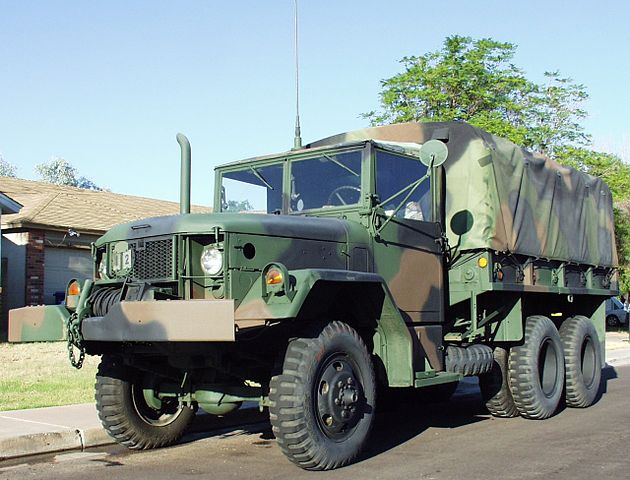
M35A2 with winch
The M35 transmission used a stalk-like appendage located under the dashboard, between the two cabin seats. The 3-spoked steering wheel had an utilitarian column. Gauges reported on basic engine metrics on a very bland, simple flat dashboard.
Headlights, paired day road and blackout night ones in trhe tandem niches alongsided the radiator were completed by navigation lights and directions ones the fenders, protected by brush guards. They were also simple in design, rounded. The ones in the radiator side niches had additional guard bars for protection.
There was a Brake system air-assisted and hydraulic applied on the drum braked on all six-wheel, and driveline parking brake. The rear plate had gladhands for connection to trailers, and thus, full air service+emergency brakes. Each drum was made for top efficiency and could dissipate up to 12 kw (16 hp) of braking heat. Since this was a standard braking system, under 26,001 pounds (11,794 kg) the M34 did not needed commercial driver's license in the US and could roam freely on the whole domestic network. The M35 electrical system was rated for 24 volt with two 12 volt 6TL-series (military grade) batteries in series.
Variants
M35
Basic truck with the REO "Gold Comet" or Continental OA-331 127 hp (95 kW) gasoline engine inline-6. Existed in 1949 with or without winch. Initially also 4-speed transmissions.M35A1
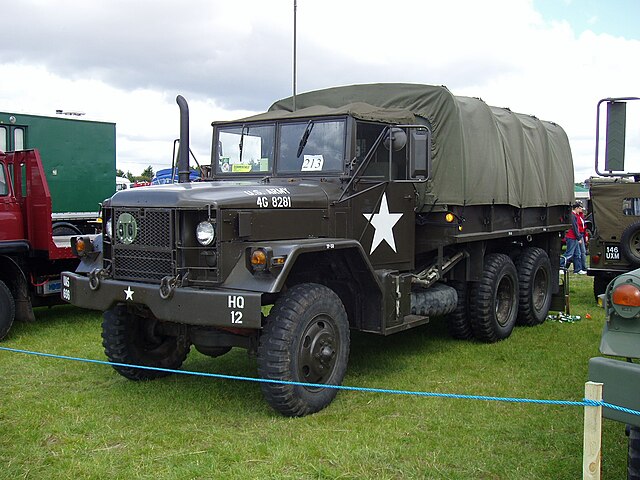
M35A1 without winch
Studebaker obtained a production contract from 1951 into early 1960s and Curtis-Wright contract in 1958 (dump trucks only), still with Continental gas engine. The M35A1 was equipped for the first time with a Continental LDS-427-2 turbo engine, either the 4-450 Schwitzer turbo, later 4D454C Schwitzer turbo. "direct 5th" transmissions: The 5th gear was an overdrive. The 140 hp engines were not reliable however due their headgasket failures.
M35A2
Kaiser M35A2 (1969) in recent exhibit at Overloon, NL
Bulk of the production of the sixties, seventies and eighties was the M3A2 truck, which sported a more modern engine, the Continetal LD-465-1, naturally aspirated 478 CID multifuel engine, still with the A1 5th speed overdrive OD transmission. In the 1970s the LD 465-1c engine became standard, doubled by a 60Amp alternator (formerly 25Amp generator). The engine was also turbocharged, leading to the LDT 465-1c (for "turbo clean air"), to clean the black exhaust on Non Turbo engines. This engine was upgraded and re-rated from 130 to 135 HP. The early tubos were the 3LD305 and later the 3LJ319 ("whistler"), and finally the LDT-465-1D, last Multi Fuel engine, still fitted with the trusted 3LJ319 Turbo or quieter 3LM39. All had a far better head gasket sealing plus head cooling. The A2 was also the most exported variant.
M35A3
AMG Reo M109A3 (originally 1959) owned by Mike Everall
The M35A3 was a late variant, not of the 1980s, with refurbished and upgraded A1-A2s in order to reduce operational costs, improve performance. From 1994 to 1999, the A3 upgrade was planned as part of the larger "Extended Service Program". This was preceded by a competition aimed at various manufacturers, and the upgrade was tested at Aberdeen Proving Ground. Competitors for the program were AM General, South Bend, IN and Cummins Military Systems, Augusta, and AMG in 1993. In all, over 1 800 received A3 upgrades in the US military and they were powered by a Caterpillar 3116 diesel (no longer multifuel) coupled with an Allison 1545 4-speed automatic transmissions. They also came with tons of upgrated equipments.
They also had a redesigned frontal appearance and new regulation lights and bumbers, markings. No new A3 vehicles was produced this exclusively was an upgrade to the exception of the M109A3 shop vans. There was even an M35A4 upgrade, using M35A3 parts and procedures on Pre A2s gasoline-powered, and LDS 427-2 multifuel engine A2s using the LD/LDT 465-1c. Some Gas engines REO/Studebaker models could be also upgraded to multifuel configurations.
M34,36,44-46
M34: Original gasoline-powered.M36: Extra long wheelbase variant developed with a 16-foot (4.9 m) cargo bed.
M35A2C/M36A2C: Straight drop-side cargo bed.
M44,45,46 long single tandem, long double tandem, extra long double tandem chassis. The Short tandem chassis had no mark.
Specialized variants
M109A2 workshop van
The M34/35/36 family was declined into the supply/troop transport came out as a dump trucks, tractor, fuel and water tanker, wrecker, as well as M109 mobile workshop/repair vehicle and ambulance or medical van. Called the G-series the whole Army designation tree M34/M35/M36 is only known as G742.
Tanker versions
M49 fuel tanker: M44 chassis based, M49C converted from C series drop-side cargo. 1,200-gallon tanks. Triple compartments (200g front, 400g mid, baffled 600g rear), later two 600-gallon baffled tanks.M50 water tanker: 1,000-U.S.-gallon (3,800 L; 830 imp gal) water tank, later internal baffles to enable better weight transfer.
M35 with portable water supply and pump (wildland firefighting truck).
Van versions
The van bodies variants had the original flatbed entirely replaced, but there are some version which van box is installed in a wrecker.M109: maintenance shop van.
M185: machine shop version with PTO winch, light duty crane, tools and M105 trailer.
M292: expandable van with hydraulic lift gate.
XM411: M109 for MGM-18 Lacrosse missile as Ground Guidance Electronics van
XM412: M109 for MGM-18 Lacrosse missile, tools and test equipment for XM411.
M132: Medical van
Dump Trucks
M60: Based on M45 chassis, similar M108 crane truck. Used for the Lacrosse missile.M47 dump truck: M44 chassis, 166-in wheelbase.
M59 dump truck: M45 chassis, 166-in wheelbase.
M342: Replacement with full length 178-in wheelbase M45 chassis, also replacing the M215 (M135).
Tractors
M48: Semi-trailers tractor, full-length M45 chassis (178 in wheelbase)M275: Same on shortened M45 chassis (166 in wheelbase). For both, few produced.
Others
V-17 pole derrick: Based on M45 chassis.V-18 auger truck: Based on M45 chassis.
M756: Specialized pipeline repair vehicle for telephone line repair
M764: Earth-boring vehicles, and its pole-setting variant (no Mark).
Combat Operations
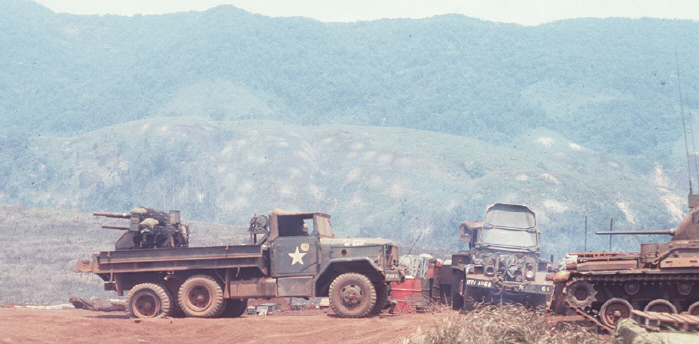
M35A1 dump truck with with Quad .50 cal. at Khe Sanh Combat Base, 1968
First battleground for the brand new truck was the Korean War, which started with scores of worn out WW2 GMC CCKW and studebakers trucks available in June of 1950, they were loaded on ships and shipped by the thousands, or re-routed from Europe to the Pacific and participate in the war effort. Still, until the ceasefire fire of 1953, the very first production vehicles from Reo were deployed in various units and tested. However it was not until the Vietnam War that the M35 had almost completely replaced vintage models.
Many were required to various stations created within the Republic of Vietnam in 1965 and while a logistics train was setup to deserve more and more isolated outposts from the coast and capital. The M35A1/A2 were used as supply trucks and troop carriers, but many were aalso used as prime movers, and since it was available in large numerbers, it gained a considerable palette of mission-specific variants not previously thought of by the manufacturers.
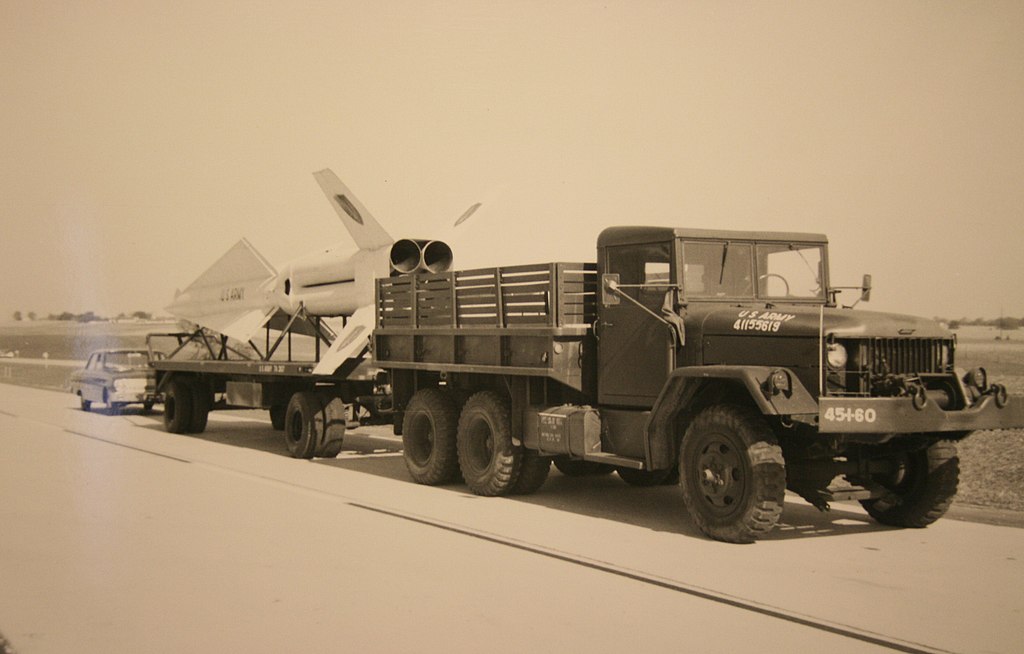
Towing nukes in Europe: M35 towing the Nike Herkules (MIM-14). It could intercept ballistic missiles, had a range of about 100 miles (160 km) top speed above 3,000 mph (4,800 km/h), maximum altitude 150,000 ft or 30 km with its solid fuel boost, sustainer rocket motors.
As convoys were setup, going through enemy-controlled territories, the danger of land mines and ambushes started to take heavy toll. So much so that after 1967, convoys started to be heavily guarded, with armoured cars when available or just by arming jeeps or the trucks themselves. Soon, with the help of crafty workshops with available boiler plates, veritable "War Wagons" started to be used as well, and to early sandbags strapped to defeat RPG-7s, add-on 1/4 inch armor plating replaced them on the sides, loosely welded, while sand bags were relocated to the floor panels as a moderating measure against mines (tanks started to do the same).
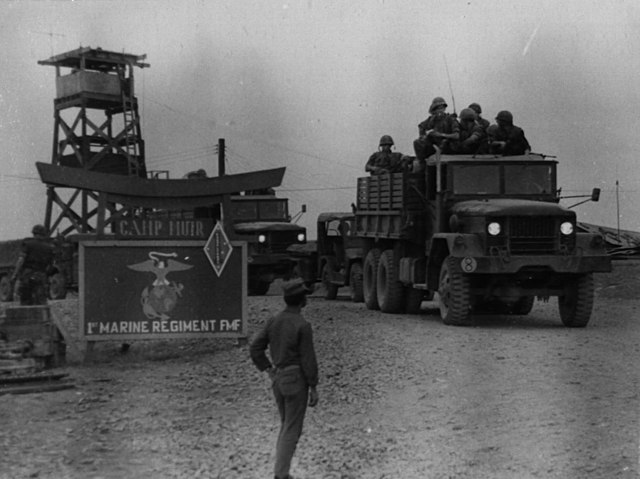
M35A1 from the 4th Bat. 11th Marines leaving Camp Miur 7 March 1970
Transport companies created after 1968 their own field-improvised gun trucks, and they received stock 7.62mm M60 on twin mounts, 40mm M79 single-shot grenade launchers and ports for the M16 assault rifles, as well as shotguns and pistols. When available, some obtained even a Browning M2 or even the rarer XM134 minigun Gatling. The 0.5 cal. soon becale the most feared of all weaponry deployed against North Vietnames and Vietcong fighters. The standard issue one was already mounted on a regular turret ring on the truck cabin roof, and one of these was fielded for every 15 or 20 vehicles in the convoy, but that was clearly not enough.
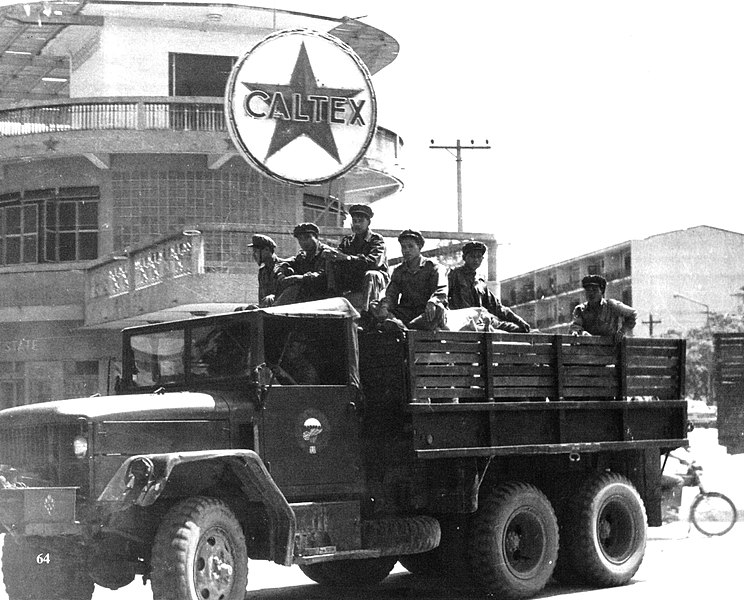
M35A2 in Ventianne, 1973
M35 gun being improved over time, after Vietnam, A2s received some upgrades and the A3 started to be fielded in Bosnia and the Gulf as part of Operation Iraqi Freedom. The M35 dump truck stayed in service for much longer in specialized units, working with the M275 tractors and the M108 obtained a crane while the M109 mobile workshop did miracles for repairs on-the-spot.
The M35A1 were retired in the 1980s or upgraded to the A3 standard, as the A2, and the very last of these were deployed with the National Guard units well into the 2000s, but it served in all branches before, the USMC and US Navy and USAAF as well. It became by far the most versatile and successful vehicle in the US armed forces history, on par with the Jeep perhaps. M35s were widely exported and also took on many wartime roles, notably during the Indian-Pakistanu war of 1971. More recently, some 400 were sent to Afghan National Army as part of the "Afghan Freedom Support Act". As of today, the venerable M35 is going to be replaced by the Medium Tactical Vehicle (FMTV) family.

Medium Tactical Vehicle (FMTV): The 6x6 unarmoured M1096 A1R MTV Long Wheelbase (4.5 m) Chassis at the Stewart & Stevenson's Sealy Texas production facility.
Gun trucks
 The versatility of the M35 is shown notably in the scores of "gun truck" created for patrol duties and convoy escort in Vietnam. First examples only had a light gun mount over the cargo bed, secured in place. Such cobnversion was already made in Africa, at Congo-Leopoldville in 1965 and the weapon was an Oerlikon GAI 20 mm anti-aircraft gun. Also in Congo mods mounted 2.75" aircraft rockets onpedestal, also on the cargo bed as improvized artillery but this was not a success.
The versatility of the M35 is shown notably in the scores of "gun truck" created for patrol duties and convoy escort in Vietnam. First examples only had a light gun mount over the cargo bed, secured in place. Such cobnversion was already made in Africa, at Congo-Leopoldville in 1965 and the weapon was an Oerlikon GAI 20 mm anti-aircraft gun. Also in Congo mods mounted 2.75" aircraft rockets onpedestal, also on the cargo bed as improvized artillery but this was not a success.
The U.S. military in Vietnam were provided with a larger array of weapons and light iron and steel plating and Army Artillery Battalions assigned to Batteries received in priority .50-caliber equipped M35 trucks. A few also received the M55 Quadmount as anti-personal heavy firepower defence. Single M60 machine guns, then twin, as well as M79 grenade launchers were also mounted in various pintles in the flatbed. The M35 later became standardized as prime mover for the M55 Quadmount and now included the dismounted, former towed trailer (M45 mount) relocated on the bed. The M55 system also was mounted on the M54 truck.
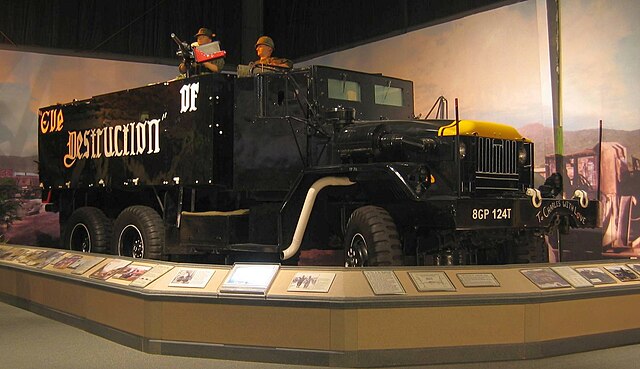
Eve of Destruction, Exterior. This was a 5-ton M54-based gun truck at Fort Eustis
Simplified armored versions were made for convoy escort, the most known "gun trucks" with mad max like flavour. In specialized workshops were mounted armored walls of various thicknesses depending on what was available, to standard cargo variants. Some had a smaller bed-mounted multi-angle "box" over a standard bed or dump bed; A very large variety of weapons was used, from LMGs to HMGs, grenade launchers, miniguns, flamethrowers and rarely including the recoiless rifle M12.
In 1971-72 as thes trucks were removed from service, those not passed on to the SVNA were returned to their initial configuration. Upon insistance to save it by truckers vets, a single original one was shipped to the U.S. Army Transportation Museum, where it resides still at Fort Eustis in Virginia since 1971. This the famous "Eve of Destruction" from a popular tube of the time by Barry McGuire.
Post-Vietnam saw many veterans building full size replicas of their original Gun Trucks from worn out, sold M35, but also M54 trucks, Dump Trucks for show. There is also a functional display replica of "Psychotic Reaction" based on an M35A2 which is a frequent host of many vehicle displays, Vietnam vets reunions to this day.
Other armoured M35s
 This was not left unnotice abroad, as shown by El Salvador converting M35s left right and center into basic, or far more complex armored trucks in the 1980s as well as Magirus Deutz trucks, the famous "Mazingers".
This was not left unnotice abroad, as shown by El Salvador converting M35s left right and center into basic, or far more complex armored trucks in the 1980s as well as Magirus Deutz trucks, the famous "Mazingers".
The Philippine Marine Corps, which received scores of M35A2s and recently A3s, still using these today, also converted them in armored configuration, from 2004. The was called "Talisman" recycling parts of a cannibalized LVTP5 while other used more standard components and shared similarities with Vietnam gun trucks. The Philippine Marine Corps created also its own anti-aircraft unit in 2006 using M35s with the Mk 56 Mod 0 mount from decommissioned ex-US PBRs with twin M2 Browning machine guns, of a single Oerlikon 20 mm.
Colombia's REO M35 "Meteoro" also had been converted as armored trucks, locally fabricated to guard tourist bus, or as mobile checkpoints against the cartels. In general, they had no protection standard, but displays a 7.62 mm (.308-cal) or .50-caliber (12.7 mm) machine gun with or without gun shields. The most advanced had their cab and fuel tanks armored and the cargo bed modified with a raised armored box and gun tower above, and up to four heavily weapon stations facing each angle. The most heavily armed had two .50-cal. HMGs front and back, two or four 7.62 mm LMGs to the sides. But since the cartels started to use RPGs, they were gradually replaced by BTR-80 Caribe.
Venezuela, also a user of the type, started to creat its own tank variants for water or fuel and at the Centro de Mantenimiento de Blindados del Ejército Venezolano (CEMABLIN) they created an anti-air/ground support variant, with six made in the early 1998 called "Fénix" system. They were assigned to the 1103º BDAA armed with 40mm guns, and Fort Yaurepara, Zulia state. The tower was too heavy however and they had a hard time shooting accurately on the move, retired in 1998. They were replaced by AMX-13 M55/M4E1 "Ráfaga". The "Fénix" had the same M4E1 turret as the M42 Duster with twin Bofors 40 mm gun, or two M50 machine guns in a cylindrical tower made of welded armor plate, open topped.
Operators
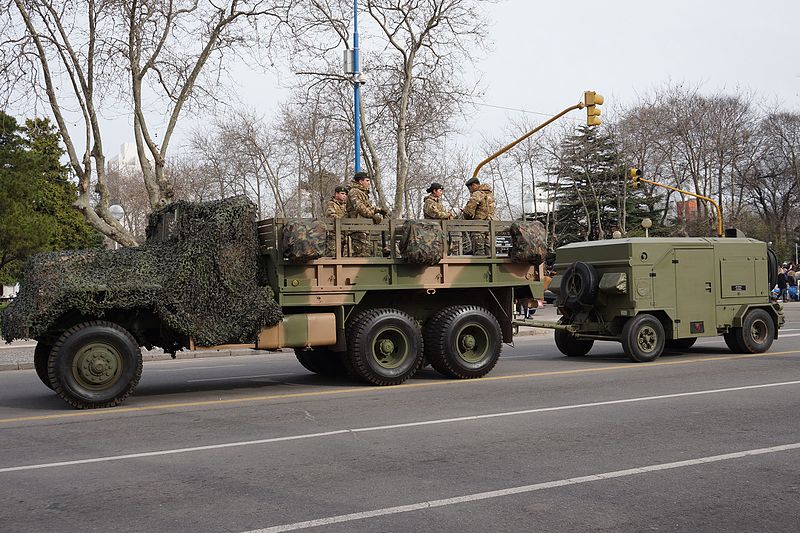
Argentinian M35
Greek Cypriot vehicle
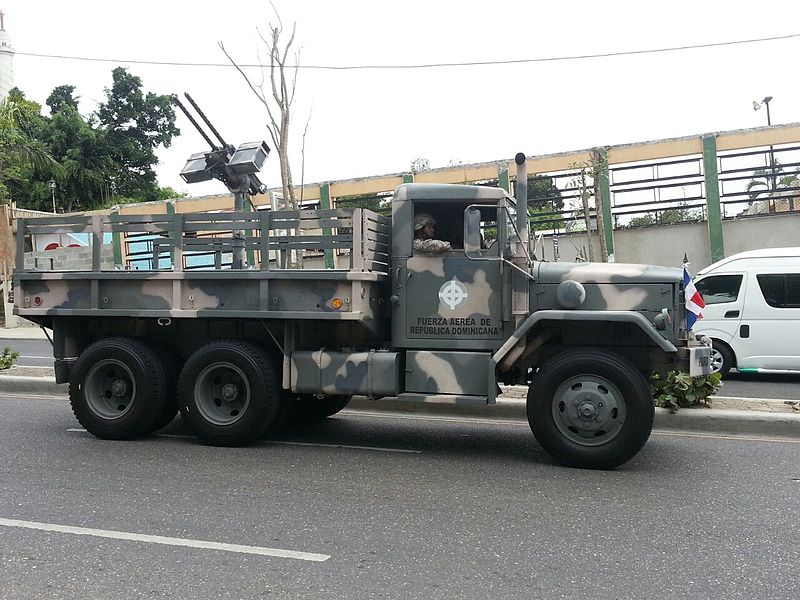
M35 of the fuerza aerea cheposo, Dom. Republic
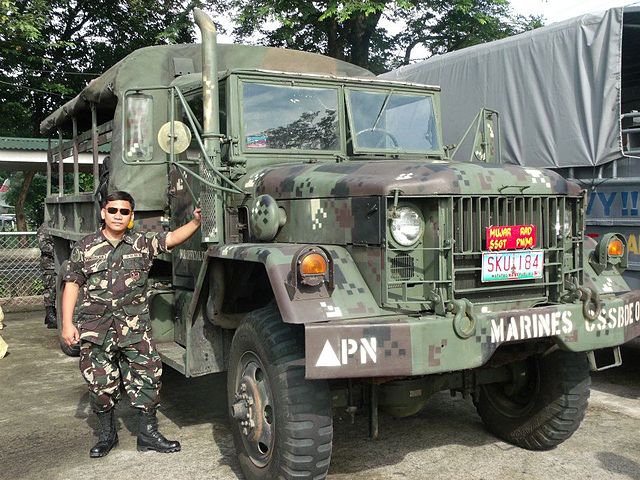
M35 of the Philippines Marines, note the "digital camo" pattern

Spanish M35
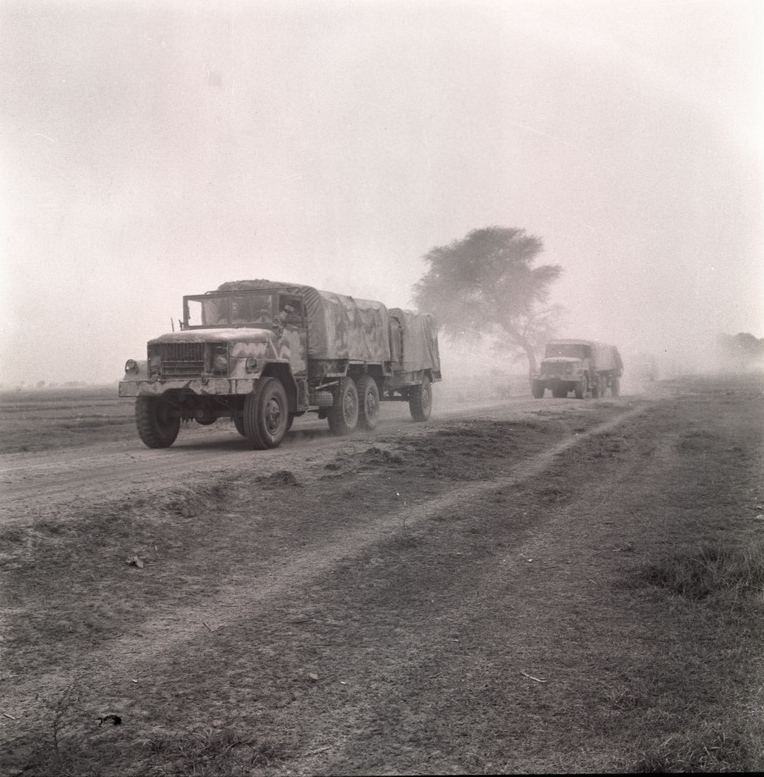
Pakistani M35 trucks, 1971 war
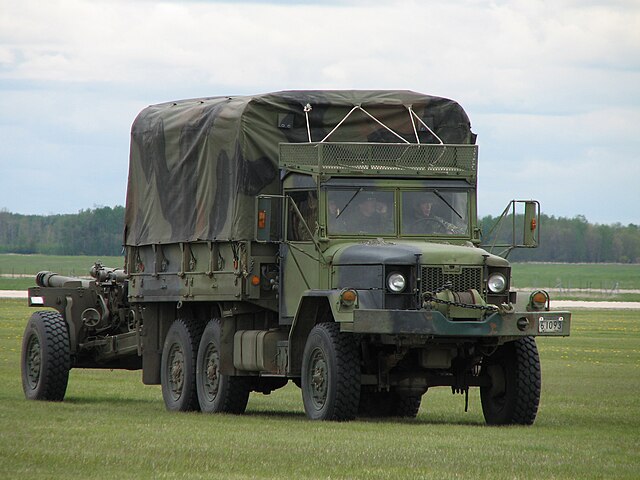
Bombardier MLVW as of today, used as prime mover.
The two main licenced variant was to Canada by Bombardier as the MLVW and South Korea by Kia Motors as the Kia KM250, still the main military heavy truck of the South Korean Army today.
Bombardier MLVW To replace its vintage wartime M135 fleet, the Canadian Army purchase the license for the M35 and its M36 variant to be manufactured by Bombardier in 1982. As of 2020, under the acronym MLVW (Medium Logistics Vehicle, Wheeled) they are still in service, albeit gradually some are cannibalized to keep the fleet runnins. In serie they have a hard cab roof and adjustable driver's seat. There is now an Allison MT-643 automatic transmission coupled to the original A2 pattern Detroit Diesel engine (500 cu.in or 8.2 L) and single wheels on the rear axles. There is also an ether-start for winter. In 2002 tyres were replaced by Michelin radials on bolt-together wheels. Replacement (Medium Support Vehicle System Project) had been selected. MLVWs never ventured into Afghanistan before an armor kit was developed for a limited deployment.
Kia KM250
Operators so far (some former): Argentina, Austria, Bolivia, Brazil, Cambodia, Canada (replaced them with the MSVS), Chad, Chile (Chilean Army/Marine Corps), Colombia, Democratic Republic of Congo, Denmark, Djibouti, Dominican Republic, Ecuador, Egypt, El Salvador, Fiji, Georgia, Greece, Guatemala, Honduras, Indonesia, Iran, Israel, Jordan, Laos, Lebanon, Liberia, Mexico, Morocco, Nicaragua, Norway, Moldova, Pakistan, Panama, Philippines, Portugal, South Korea (K-511/A1), Saudi Arabia, Sudan, Sweden (evaluation), Taiwan (replaced by International 7400 trucks), Thailand, Tunisia, Turkey, Venezuela, Vietnam.
M35 (1950) specification tables | |
| Dimensions (L-w-h) | 6.7 x 2.4 x 2.9 m |
| Wheelbase | Depending on type |
| Curb weight | 6 tons |
| Payload | 2.27/4.5 t |
| Crew | 1+2 men, 20 troops |
| Propulsion | Reo or Continental petrol 146 hp |
| Transmission | 6x6 |
| Top speed | 77-90 km/h |
| Maximum range | 480 km |
Gallery
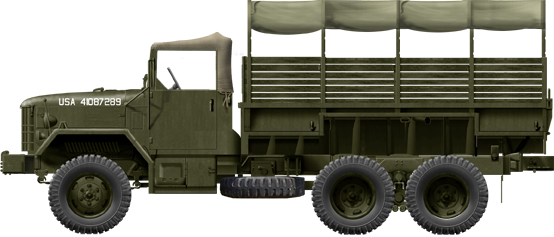
M35 from 966th transport Unit

Pakistani M35, 1971 war
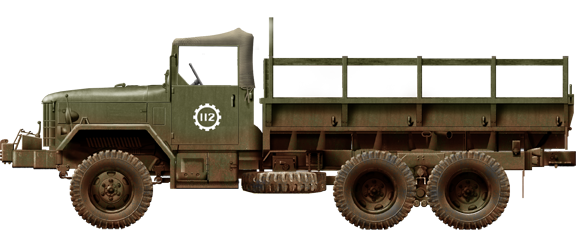
M35 of the ARVN, 1970s
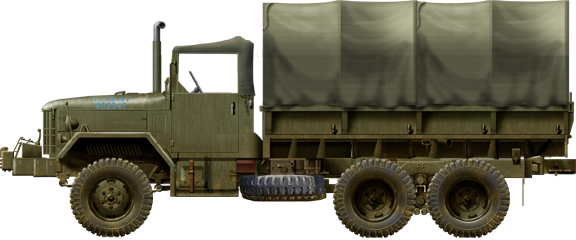
Basic winch-equipped M35A2 in the 1960s

NATO Germany Bat. Berlin US M35A2 with trailer, 1970s

IDF M35 with AGM-78 SPAAML
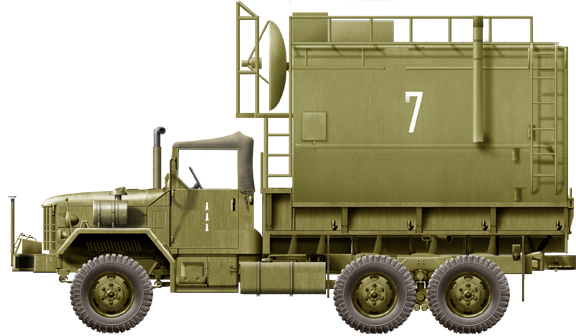
IDF M35 D805G Meteo Communication Command Truck, 282th Artillery Bat.
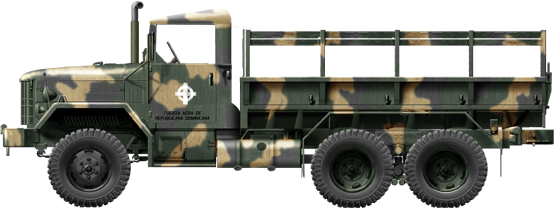
M35A2 of the Dominican AF
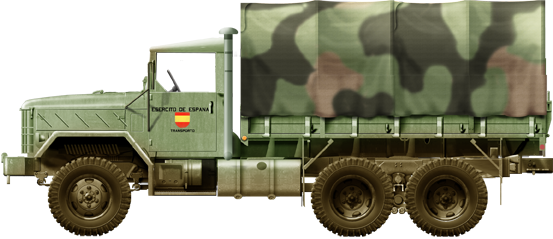
Spanish M35A2
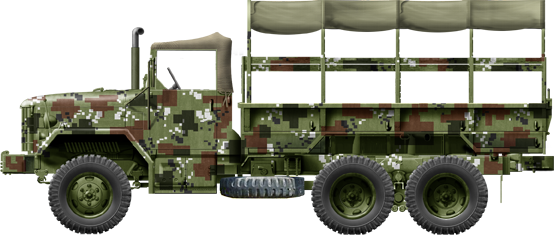
Philippine Marines M35A2

M35A3, 100th Infantry Bat. 442 Rgt.
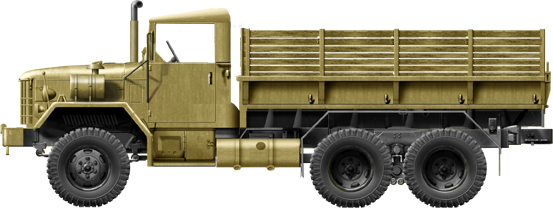
M35A3 Gulf War 1991

Greek M35A3
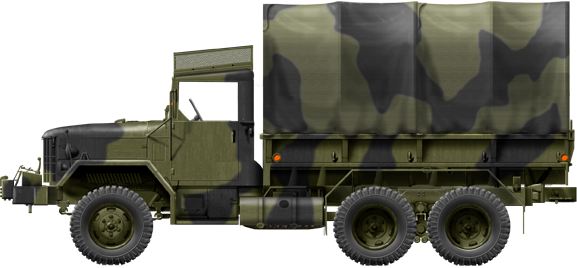
Canadian variant MLVW

M109A2 workshop
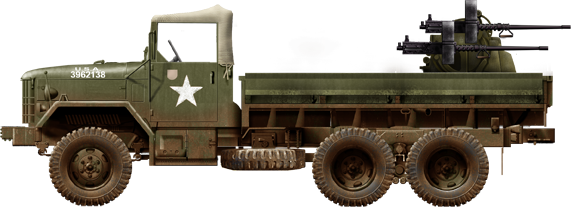
M35A1 Dump Truck with quadmount 0.5 cal. M45 AA, Khe Sanh 1969 (to come)

"Eve of Destruction" gun truck
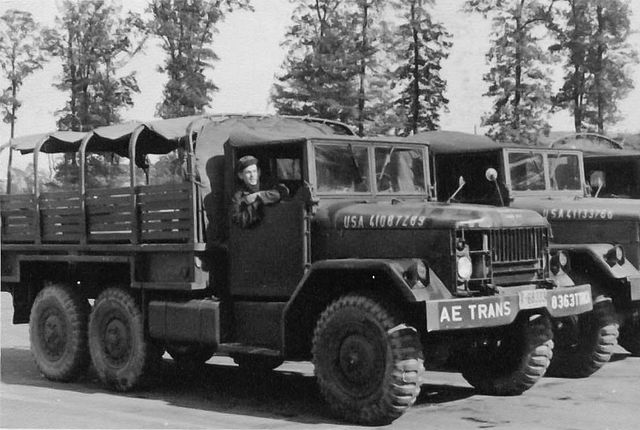
966th Transportation Truck Terminal celebrates its 60th anniversary

US Navy 25 ton 6X6 truck M35
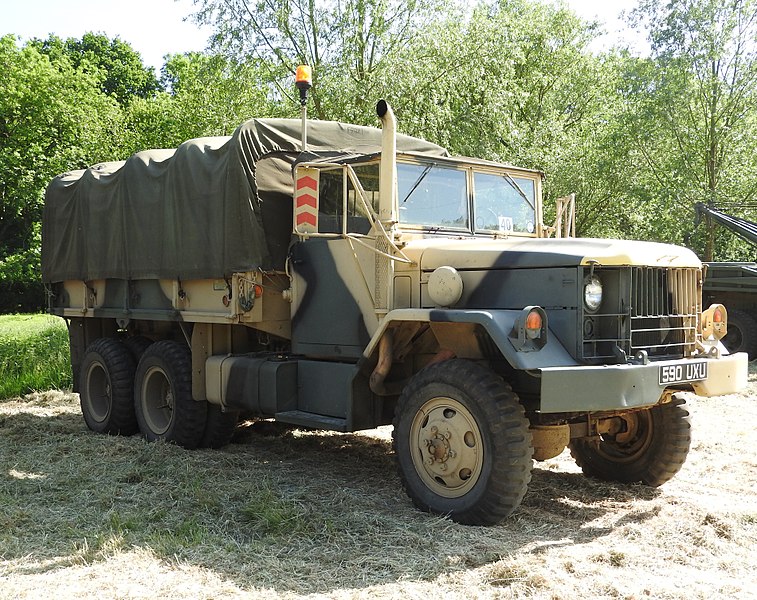
Aldham Old Time Rally 2015
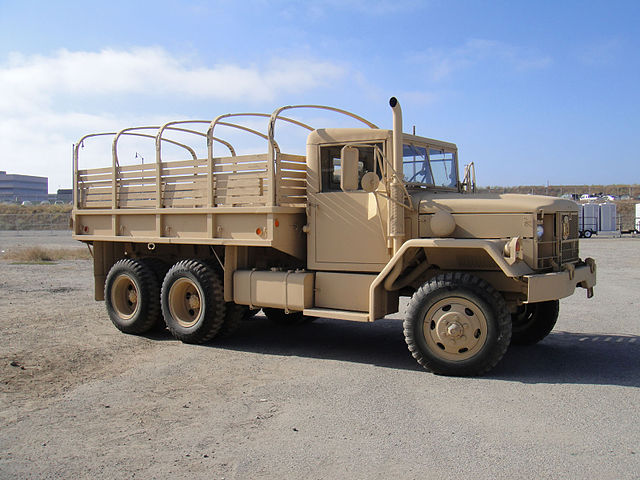
Call of Duty XP 2011

Defensegov M35 UNHCR
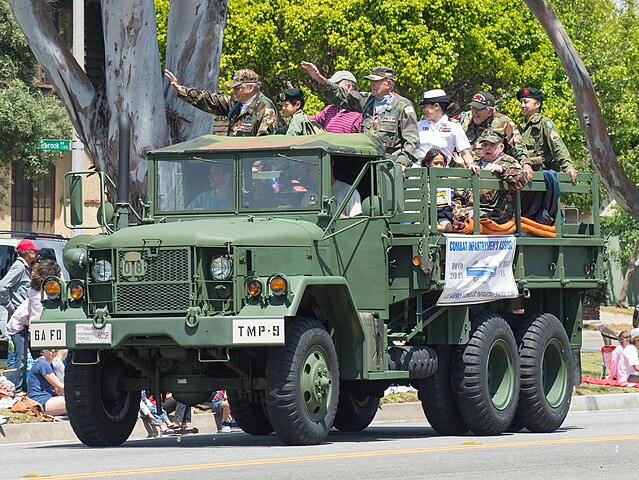
Combat Infantryman's Association parade M35

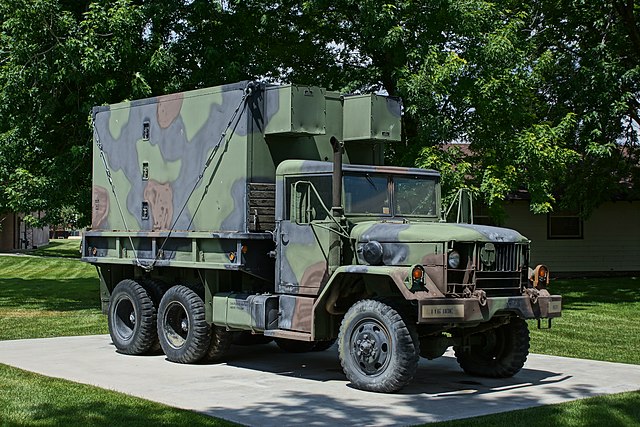
Gowen Field Military Heritage Museum, ANGB Boise, Idaho 2018
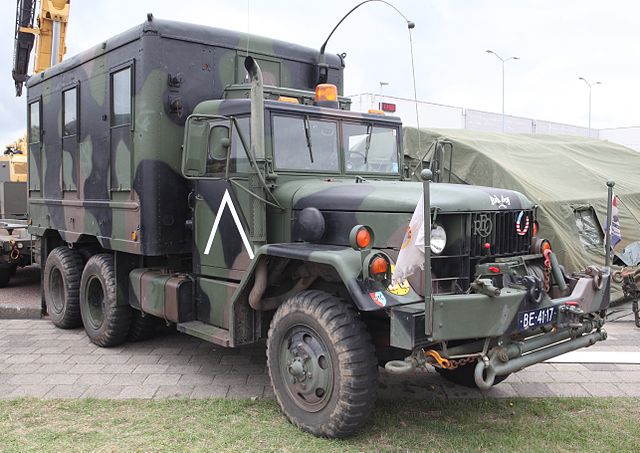
Kaiser REO truck M35A2 from Joost J.Bakker at IJmuiden

M35 at Operacja Poludnie, 2011

Reo truck
REO Kaiser AM General M35A2 Deuce and a Half Truck
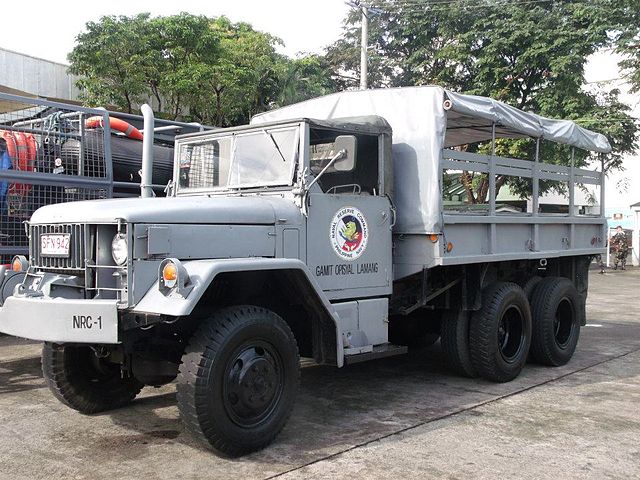
Naval Reserve Command M35
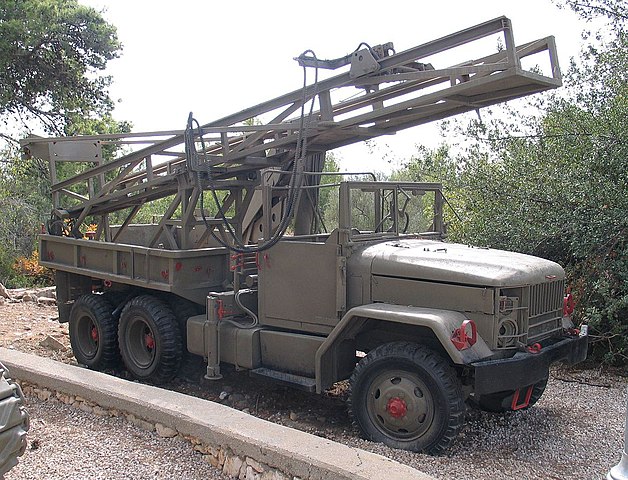
M35 preseved at beyt hatochan, Missile carrier conversion
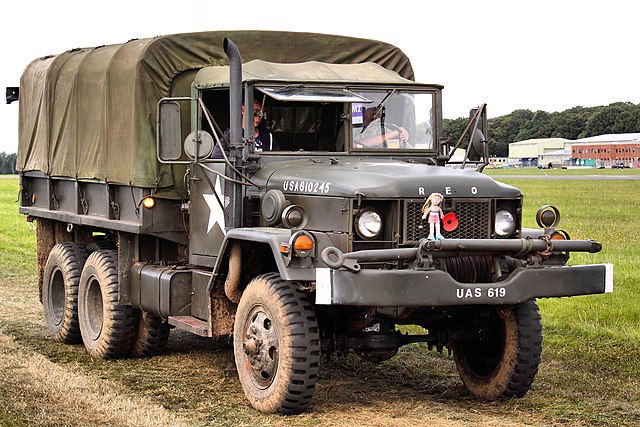
M35 ta Dunsfold Wings & Wheels 2014
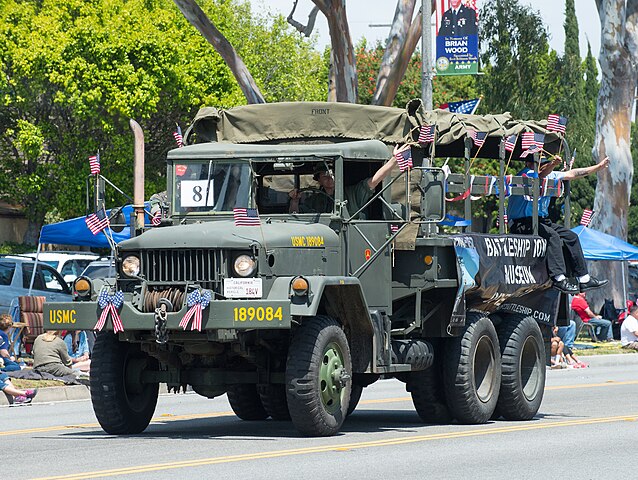
US Navy Battleship USS Iowa vets day, Navy M35
NJAHOF Army Vehicles

530B structural pumper firefighting vehicle
M109A2 Shop Van
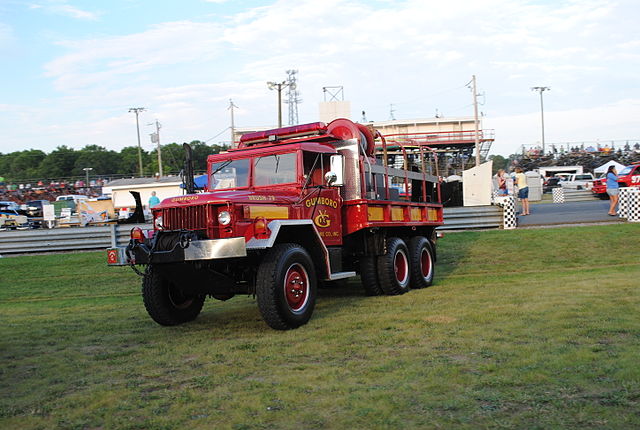
2012 Camp Barnes and Delaware State Police Benefit Stock Car Race

Roadrunners Race 61, Finowfurt
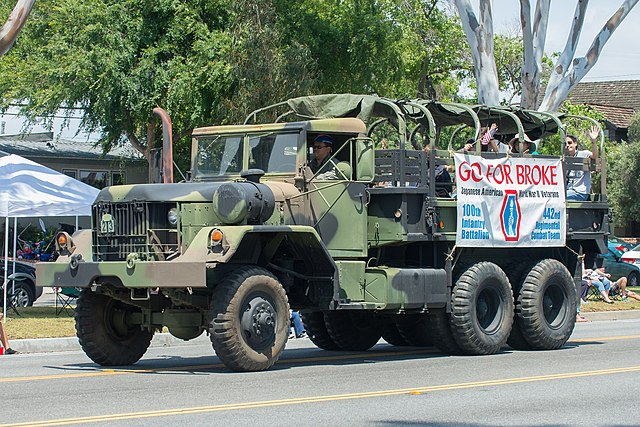
442nd Regimental Combat Team
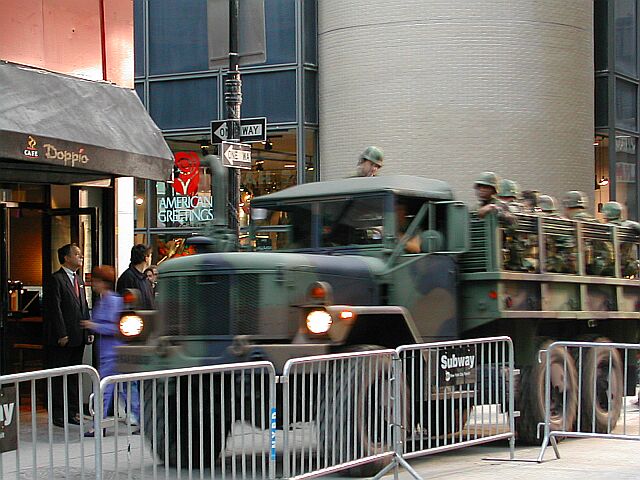
Korean M35 guard transport
Sources
Doyle, David (2003). Standard catalog of U.S. Military Vehicles. Krause PublicationsLyles, James. The Hard Ride; Vietnam Gun Trucks (Volume II). Quezon City Planet Art, 2003
Montes, Julio. Mexican and Central American Armor. Darlington Publications, 2001
Rottman, Gordon and Donald Spaulding. Vietnam Armor in Action. Concord Publications 2002
Spencer, David. Armored Fighting Vehicles of El Salvador. Darlington Publications 1995
Standard Military Vehicle Characteristic Data Sheets. US Army Ordnance Tank-Automotive Cmd. 1959
TM-9-819 2½ ton 6x6 Cargo truck M34 (and others). US Department of the Army. 1952.
TM 9-2320-209-10-1 Operation, Installation, and Reference Data Operator M44A1, M44A2
TM 9-2320-361-10 Operator's Manual M44A2 Series Multifuel
TM 9-2320-361-20 Unit Maintenance for 2 ½-ton, 6x6, M44A2 Series Multifuel
TM 9-2320-386-10 Extended Service Program (ESP) Operator's Manual M44A3 Series Diesel
TM 9-2320-386-24-1-1 Extended Service Program (ESP) Unit M44A3 Series Diesel
TM 9-2320-386-24-1-2 Extended Service Program (ESP) Unit M44A3 Series Diesel 2
TM 55-2320-209-15 Transportability Guidance Trucks, 2-1/2-ton, 6x6 Truck, Cargo (several models)
trucksplanet.com
militarytoday.com
militaryfactory.com
colemans.com
hmdb.org
globalsecurity.org
dieselarmy.com
Popular Science sept. 1950
jatonkam35s.com
olive-drab.com/
commons.wikimedia.org
missing-lynx.com
Gun Trucks
Gun Trucks, by David Doyle (Ampersand Group)US Army Truck Tractors in Detail, by F Korán, J Moštek, J Spurný, M Hraban and RC Foulks (Wings and Wheels)
Vietnam Gun Trucks, by Gordon L Rottman (Osprey)
Videos
The M35 in action
Gun trucks in Vietnam.
 WW1 Vehicles
WW1 Vehicles
 WWI trucks
WWI trucks
 British WWI Vehicles
British WWI VehiclesLGOC B-type troop Bus
Mack AC
Pierce-Arrow AA truck
BSA 14/18 hp-20/25 hp
BSA 13.9 h.p
Lanchester staff Car
Thornycroft J
Maudslay Lorry
AEC Y Type
Foster-Daimler Tractor
Motorc. Triumph H
Ford Model T Patrol Car
FWD Model B 3-ton Lorry
Leyland 3-ton truck
Vulcan truck
Vauxhall D-type staff car
Crossley 20/25 staff car
 French WWI Vehicles
French WWI VehiclesBerliet CBA
Berliet Type M
Châtillon-Panhard Tractor
Panhard K11
Latil TAR Tractor
Panhard-Genty 24 HP
Renault EG
Renault AG1 Landaulet
Renault Truck 60CV
Renault FB Artillery Portee
Schneider CD Artillery Tractor
 Russian WWI Vehicles
Russian WWI Vehicles(list in research)
 US WWI Vehicles
US WWI VehiclesHolt tractor
Liberty Trucks, assembled by:
- Bethlehem
- Brockway
- Diamond T
- Gardford
- Gramm-Berstein
- Indiana
- Kelly-Springfield
- Packard
- Pierce-Arrow
- Republic
- Selden
- SMTC
- Sterling
- USMTC
- Velie
- Dart
- Lafrance
Ricker truck
Ford Model T Mil.
Spruce log truck
Dodge M1918 Light Repair truck
Dart BB, E, L, Liberty CC4, J Tractor
5-ton Artillery Tractor
Ford Model T Ambulance
Mack AC "Bulldog" Truck
Holt 15-ton Tractor
Jeffery Quad Lorry
FWD Model B
FWD SU-COE
 Italian WWI Vehicles
Italian WWI VehiclesLancia IZ
Fiat 15ter Ambulance
Fiat 15ter Lorry
Fiat 18BL Lorry
Hersent-Thiriont Flamethrower
(list in research)
 Japanese WWI Vehicles
Japanese WWI Vehicles(list in research)
 Belgian, Dutch and other WWI vehicles
Belgian, Dutch and other WWI vehiclesBerna C2 Truck (Swiss)
(list in research)
 German WWI Vehicles
German WWI VehiclesA7V Überlandwagen
Beobachtungsanhänger
Büssing KZW1800 Artillery Tractor
Daimler Marienfelde Truck
Field Artillery Limbers
Große FeldKüche Hf.13
Mercedes 37/95 Staff Car
(list in research)
 Austro-Hungarian Vehicles
Austro-Hungarian VehiclesAustro-Daimler Lorry
Austro-Daimler Artilleriezugwagen
B-Zug Artillery Tractor
Feldküche M.1915
 Turkish WWI Vehicles
Turkish WWI Vehicles(list in research)
 Allied ww2 Vehicles
Allied ww2 Vehicles
 British Vehicles
British Vehicles
-AEC Armoured Command Vehicle (415)
-AEC Matador
-Albion CX22S
-Albion FT15N
-Albion WD.CX24
-Austin K2/Y Ambulance
-Austin K3
-Austin K4
-Austin K4 Dropside
-Austin K5
-Austin K6 GS
-Austin K6 Gantry
-Bedford MW
-Bedford OXA Armoured
-Bedford OXC Semi-trailer
-Bedford OXD GS
-Bedford OYC Tanker
-Bedford OYD GS
-Bedford QL series (QLD, QLR/QLC QLT TC)
-CMP FAT
-Commer Q2
-Crossley Q-Type
-Diamond T tank transporter
-Guy Quad-Ant FAT
-Guy Lizard ACV
-Humber FWD
-Karrier KT4
-Karrier K6
-Leyland Hippo Mk I/II
-Leyland Lynx
-Leyland Retriever
-Mack EXBX
-Morris 15cwt
-Morris CDSW
-Morris ML Ambulance
-Morris C8 GS/FAT
-Morris Commercial CD series
-Morris Commercial CS8
-Morris C9
-Morris GS Terrapin
-Morris PU
-Scammell Pioneer
-Scammell Pioneer TRCU
-Scammell Pioneer SV1S/T
-Thornycroft Hathi (1924)
-Thornycroft Nubian
-Thornycroft Tartar
-AEC Matador
-Albion CX22S
-Albion FT15N
-Albion WD.CX24
-Austin K2/Y Ambulance
-Austin K3
-Austin K4
-Austin K4 Dropside
-Austin K5
-Austin K6 GS
-Austin K6 Gantry
-Bedford MW
-Bedford OXA Armoured
-Bedford OXC Semi-trailer
-Bedford OXD GS
-Bedford OYC Tanker
-Bedford OYD GS
-Bedford QL series (QLD, QLR/QLC QLT TC)
-CMP FAT
-Commer Q2
-Crossley Q-Type
-Diamond T tank transporter
-Guy Quad-Ant FAT
-Guy Lizard ACV
-Humber FWD
-Karrier KT4
-Karrier K6
-Leyland Hippo Mk I/II
-Leyland Lynx
-Leyland Retriever
-Mack EXBX
-Morris 15cwt
-Morris CDSW
-Morris ML Ambulance
-Morris C8 GS/FAT
-Morris Commercial CD series
-Morris Commercial CS8
-Morris C9
-Morris GS Terrapin
-Morris PU
-Scammell Pioneer
-Scammell Pioneer TRCU
-Scammell Pioneer SV1S/T
-Thornycroft Hathi (1924)
-Thornycroft Nubian
-Thornycroft Tartar
 Canadian Trucks
Canadian Trucks
-Ford F8 CMP
-CMP C15/F15 (1940)
-CMP CGT/FGT FAT (1942)
-CMP C30/F30 LRGD (1942)
-CMP C30/F30 (1940)
-CMP C60/F60 LWB (1941)
-CMP C60/F60 SWB (1942)
-C-60X 6x6 CMP
-F-60H 6x4 CMP
-Ford F-GT CMP
-Chevy C-GT CMP
-C8A 1C1 HUP
-Chevrolet 3 ton truck
-Chevrolet WB 30cwt LRDG
-Chevrolet C8/C8A 4x2 CMP
-CMP C15/F15 (1940)
-CMP CGT/FGT FAT (1942)
-CMP C30/F30 LRGD (1942)
-CMP C30/F30 (1940)
-CMP C60/F60 LWB (1941)
-CMP C60/F60 SWB (1942)
-C-60X 6x6 CMP
-F-60H 6x4 CMP
-Ford F-GT CMP
-Chevy C-GT CMP
-C8A 1C1 HUP
-Chevrolet 3 ton truck
-Chevrolet WB 30cwt LRDG
-Chevrolet C8/C8A 4x2 CMP
 French Vehicles
French Vehicles
-Berliet DGRA
-Berliet GDC
-Berliet GDM
-Berliet VDCA
-Berliet 30
-Bernard fuel carrier
-Citroën Kégresse P14 .
-Citroën Kégresse P17
-Citroën Kégresse P19
-Citroën 23U
-Citroën 32U
-Citroën T45
-Citroën Traction Avant
-ELMAG
-Fiat France 38R
-Ford France
-Hotchkiss PKW Type 680
-Hotchkiss 686
-Hotchkiss 686 PNA
-Isobloc W843M medical bus
-Laffly S15R
-Laffly S15T
-Laffly S15R
-Laffly S35T
--Laffly V15T
-Laffly W15T/R
-Laffly 20TL
-Laffly 25
-Laffly 45
-Latil TAR H2
-Latil M2Tl6
-Matford F917
-Panhard K113 Truck
-Panhard K125 Truck/Bus
-Peugeot 202
-Peugeot 402
-Peugeot DMA
-Peugeot DK
-Peugeot DK5
-Renault AHS
-Renault AHN
-Renault AHR
-Renault AGC
-Renault ADK
-Renault ADH
-Renault AHSs
-Renault YCR (TRC-36R)
-Saurer type 3CT
-Simca 5 staff car
-Simca 8 staff car
-Somua MCL
-Somua MCG
-Talbot staff car
-Unic TU1
-Unic P107
-Trippel SG6
-Willeme DU10
-Berliet GDC
-Berliet GDM
-Berliet VDCA
-Berliet 30
-Bernard fuel carrier
-Citroën Kégresse P14 .
-Citroën Kégresse P17
-Citroën Kégresse P19
-Citroën 23U
-Citroën 32U
-Citroën T45
-Citroën Traction Avant
-ELMAG
-Fiat France 38R
-Ford France
-Hotchkiss PKW Type 680
-Hotchkiss 686
-Hotchkiss 686 PNA
-Isobloc W843M medical bus
-Laffly S15R
-Laffly S15T
-Laffly S15R
-Laffly S35T
--Laffly V15T
-Laffly W15T/R
-Laffly 20TL
-Laffly 25
-Laffly 45
-Latil TAR H2
-Latil M2Tl6
-Matford F917
-Panhard K113 Truck
-Panhard K125 Truck/Bus
-Peugeot 202
-Peugeot 402
-Peugeot DMA
-Peugeot DK
-Peugeot DK5
-Renault AHS
-Renault AHN
-Renault AHR
-Renault AGC
-Renault ADK
-Renault ADH
-Renault AHSs
-Renault YCR (TRC-36R)
-Saurer type 3CT
-Simca 5 staff car
-Simca 8 staff car
-Somua MCL
-Somua MCG
-Talbot staff car
-Unic TU1
-Unic P107
-Trippel SG6
-Willeme DU10
 Soviet Trucks
Soviet Trucks
-BZ-38
-GAZ AA M1927 M1932 M1941
-GAZ–MM
-GAZ AAA M1937/1940
-GAZ-60
-GAZ-65
-SU-1-12
-SU-4
-SU C-6
-SU-12
-Yag-6
-Yag-10
-Yag-10 SPG
-ZIS-5/V/BZ
-ZIS-6
-ZIS-12
-ZIS-22M HT
-ZIS-33 HT
-ZIS 41 HT
-ZIS 42M HT
-FN-Kégresse T3
Artillery tractors
-Komsomolets (4,041 pre-war)
-T-26-T
-STZ-3 (3,658 pre-war)
-STZ-5 (7,170 pre-war)
-Stalinets (ChTz S-65) (?)
-Komintern (1,017 pre-war)
-Voroshilovets (1228 1942)
-Kommunar (504 pre-war)
-YA-12 (1,666)
-Wheeled Tractor SKhTZ 15-30 (1930) Specialized Vehicles
-BM-13 Katyusha (1940) Soviet staff cars
-GAZ A
-GAZ M1 "Emka"
-GAZ 11-73
-GAZ 61-73
-GAZ 67 Amphibious armoured cars
-PB-4
-PB-7
-BAD-2
-GAZ AA M1927 M1932 M1941
-GAZ–MM
-GAZ AAA M1937/1940
-GAZ-60
-GAZ-65
-SU-1-12
-SU-4
-SU C-6
-SU-12
-Yag-6
-Yag-10
-Yag-10 SPG
-ZIS-5/V/BZ
-ZIS-6
-ZIS-12
-ZIS-22M HT
-ZIS-33 HT
-ZIS 41 HT
-ZIS 42M HT
-FN-Kégresse T3
Artillery tractors
-Komsomolets (4,041 pre-war)
-T-26-T
-STZ-3 (3,658 pre-war)
-STZ-5 (7,170 pre-war)
-Stalinets (ChTz S-65) (?)
-Komintern (1,017 pre-war)
-Voroshilovets (1228 1942)
-Kommunar (504 pre-war)
-YA-12 (1,666)
-Wheeled Tractor SKhTZ 15-30 (1930) Specialized Vehicles
-BM-13 Katyusha (1940) Soviet staff cars
-GAZ A
-GAZ M1 "Emka"
-GAZ 11-73
-GAZ 61-73
-GAZ 67 Amphibious armoured cars
-PB-4
-PB-7
-BAD-2
 Czech Trucks
Czech Trucks
-Praga N (1915)
-Praga TNSPE (1916) AC
-Praga MN, LN (1926)
-Praga RN (1933)
-Praga SND (SNDgs) (1937)
-Praga RND (1935)
-Praga T6 (1937) artillery tractor
-Praga RV (1934)
-Praga AV (1936)
-Tatra 26
-Tatra 57/57K (1932-1940)
-Tatra 72
-Tatra 82
-Tatra 92
-Tatra 81
-Tatra 111
-Praga TNSPE (1916) AC
-Praga MN, LN (1926)
-Praga RN (1933)
-Praga SND (SNDgs) (1937)
-Praga RND (1935)
-Praga T6 (1937) artillery tractor
-Praga RV (1934)
-Praga AV (1936)
-Tatra 26
-Tatra 57/57K (1932-1940)
-Tatra 72
-Tatra 82
-Tatra 92
-Tatra 81
-Tatra 111
 US Trucks
US Trucks
-Autocar U8144T 5/6-ton 4x4 truck
-Brockway/LaFrance 6-ton 6x6 truck, G512, 514, 547, 569
-Brockway 6-ton 6×6 truck
-Chevrolet m1931
-Chevrolet m1936
-Chevrolet G506 1.5 ton 4x4 truck
-Chevrolet G-7107 4-1/2 ton 4x4
-Chevrolet 3116 1-1/2 ton 4x2
-Chevrolet AFWX-354
-Corbitt 6-ton 6×6 truck
-Diamond T Model 980/981 12-ton 6x4 trucks (G159)
-Diamond T Model 968 4-ton 6x6 truck (G509)
-Diamond T Model 967
-Diamond T Model 970
-Diamond T Model 972
-Diamond M26 Dragon Wagon
-Diamond M19 Tank Transporter
-Diamond T Model 980
-Diamond T 4-ton 6x6 truck
-Dodge 1⁄2-ton truck
-Dodge WC-51/52 (3⁄4-ton Trucks, Weapons Carrier)
-Dodge WC-53 (3⁄4-ton Carryall)
-Dodge WC-54/64 (3⁄4-ton Ambulance)
-Dodge WC-55 (3⁄4-ton Truck, M6 Gun Motor Carriage)
-Dodge WC-56/57/58 (3⁄4-ton (Radio) Command Reconnaissance)
-Dodge WC-62/43 (G-507, 11⁄2-ton, 6x6 truck)
-Dodge M6 GMC
-Dodge D-15 truck
-Dodge T-234 "China/Burma" truck
-Ford B3000 S
-Ford V3000S
-Ford V3000A
-Ford BB
-Ford V8-51
-Ford m1931
-Ford V8 M1937
-Four Wheel Drive Auto Company (FWD) SU-COE 5-6 ton 4x4
-GMS 353 Bofors
-International B2
-International model 1937
-Inl KR-11 5 ton 4x2 dump truck
-Inl M5-6 318 2-1/2 ton 6x6 swb
-G8T 2-1/2 ton 4x2 Truck
-Mack NR15 10-ton 6x4
-Reo 28 XS 10-ton 6x4
-Studebaker US6x4 U-5
-Studebaker US6x4 U-7
-Studebaker US6x4 U-6
-Pacific M25 Dragon Wagon
-Studebaker US6 U4 bz35S 2-1/2 ton 6x6 truck
-T1E1(M1) half-track
-T5 half-track
-T7 half-track
-T9 half-track
-Ward LaFrance
-White 6 ton 6x6 Prime Mover
-White G-691 444T
-White 6-ton 6×6 truck G512, 514, 526, 547
 Small truck/car & Misc.
Small truck/car & Misc.
Bantam Reconnaissance Car
Ford GTB
6x6 Willys 'MT-TUG' ("Super-Jeep")
-Willys MB light truck
-Ford GPA ("Seep")
Buick Century Series 60
1941 Plymouth P11 Staff Car
Ford Fordor 1942 Staff Car
Harley-Davidson WLA motorcycle
 Tractors.
M1 Heavy Tractor:
Tractors.
M1 Heavy Tractor:
 Motorcycle
Motorcycle
-Brockway/LaFrance 6-ton 6x6 truck, G512, 514, 547, 569
-Brockway 6-ton 6×6 truck
-Chevrolet m1931
-Chevrolet m1936
-Chevrolet G506 1.5 ton 4x4 truck
-Chevrolet G-7107 4-1/2 ton 4x4
-Chevrolet 3116 1-1/2 ton 4x2
-Chevrolet AFWX-354
-Corbitt 6-ton 6×6 truck
-Diamond T Model 980/981 12-ton 6x4 trucks (G159)
-Diamond T Model 968 4-ton 6x6 truck (G509)
-Diamond T Model 967
-Diamond T Model 970
-Diamond T Model 972
-Diamond M26 Dragon Wagon
-Diamond M19 Tank Transporter
-Diamond T Model 980
-Diamond T 4-ton 6x6 truck
-Dodge 1⁄2-ton truck
-Dodge WC-51/52 (3⁄4-ton Trucks, Weapons Carrier)
-Dodge WC-53 (3⁄4-ton Carryall)
-Dodge WC-54/64 (3⁄4-ton Ambulance)
-Dodge WC-55 (3⁄4-ton Truck, M6 Gun Motor Carriage)
-Dodge WC-56/57/58 (3⁄4-ton (Radio) Command Reconnaissance)
-Dodge WC-62/43 (G-507, 11⁄2-ton, 6x6 truck)
-Dodge M6 GMC
-Dodge D-15 truck
-Dodge T-234 "China/Burma" truck
-Ford B3000 S
-Ford V3000S
-Ford V3000A
-Ford BB
-Ford V8-51
-Ford m1931
-Ford V8 M1937
-Four Wheel Drive Auto Company (FWD) SU-COE 5-6 ton 4x4
-GMS 353 Bofors
-International B2
-International model 1937
-Inl KR-11 5 ton 4x2 dump truck
-Inl M5-6 318 2-1/2 ton 6x6 swb
-G8T 2-1/2 ton 4x2 Truck
-Mack NR15 10-ton 6x4
-Reo 28 XS 10-ton 6x4
-Studebaker US6x4 U-5
-Studebaker US6x4 U-7
-Studebaker US6x4 U-6
-Pacific M25 Dragon Wagon
-Studebaker US6 U4 bz35S 2-1/2 ton 6x6 truck
-T1E1(M1) half-track
-T5 half-track
-T7 half-track
-T9 half-track
-Ward LaFrance
-White 6 ton 6x6 Prime Mover
-White G-691 444T
-White 6-ton 6×6 truck G512, 514, 526, 547
 Small truck/car & Misc.
Small truck/car & Misc.
Bantam Reconnaissance Car
Ford GTB
6x6 Willys 'MT-TUG' ("Super-Jeep")
-Willys MB light truck
-Ford GPA ("Seep")
Buick Century Series 60
1941 Plymouth P11 Staff Car
Ford Fordor 1942 Staff Car
Harley-Davidson WLA motorcycle
 Tractors.
M1 Heavy Tractor:
Tractors.
M1 Heavy Tractor:
- Allis-Chalmers Model L
- G-022 Caterpillar Model 60
- G-89 Caterpillar RD7
- G-98, G-107 Allis-Chalmers HD-10DW
- G-101 International Harvester TD-18
- G-126 Caterpillar D7
- G-153 Caterpillar D8
 Motorcycle
Motorcycle
 Axis Trucks
Axis Trucks
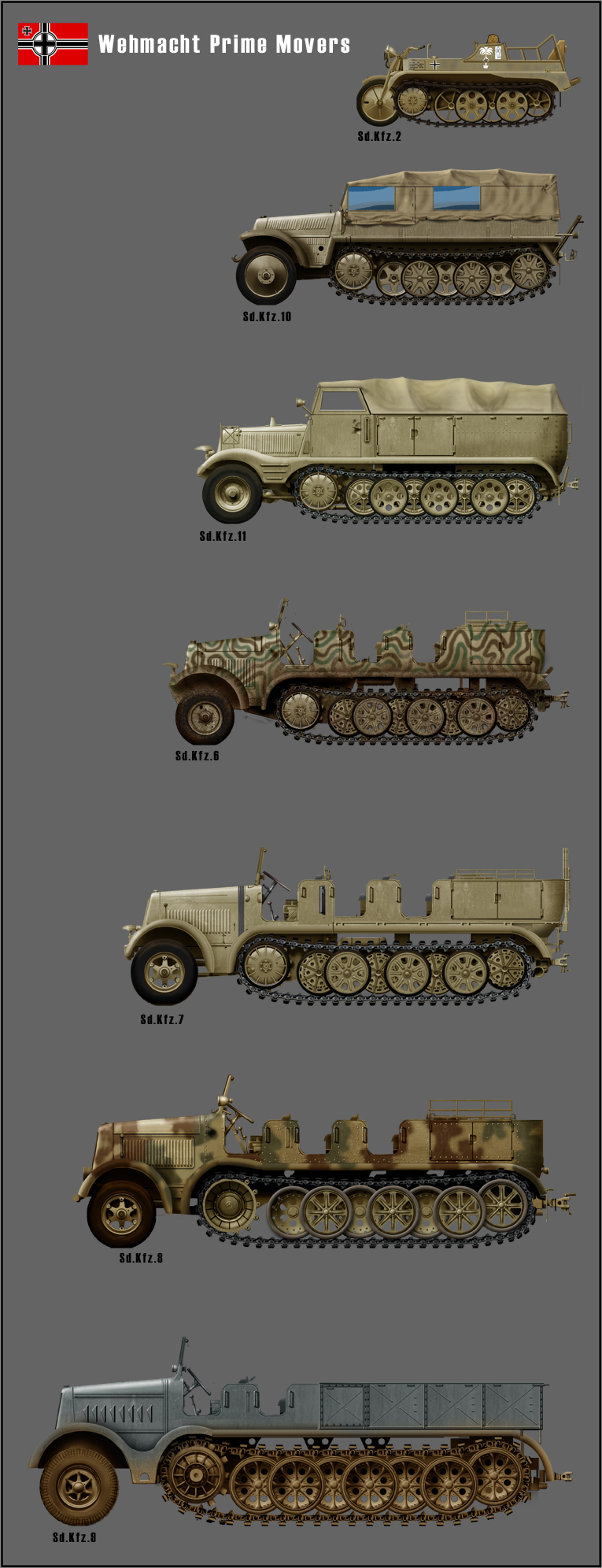
Purchase this pagemarker and support the site !
Sd.Kfz 2, 6, 7, 8, 9, 10 and 11 were half-tracks designed just before the war as prime movers, to carry supplies, ammunition, personal, and tow artillery. Many were also converted during the war as armored versions carrying AA FLAK guns (Flakvierling, 37 mm, or the legendary 88 mm Rheinmetall als used as tank hunters), or were converted as nebelwerfer (rocket launching armored vehicles). They were built by Hanomag, Steyr, Mercedes-Benz, Bussing and many other manufacturers until 1945, over 20,000 half-tracks. German Military trucks
German Military trucks
-Opel Blitz
-Mercedes-Benz L3000
-Magirus A3000
-Krupp Protze Kfz.19
-Krupp Protze Kfz.21
-Krupp Protze Kfz.68
-Krupp Protze Kfz.69
-Krupp Protze Kfz.70
-Krupp Protze Kfz.81
-Krupp Protze Kfz.21
-Krupp Protze Kfz.83
-Borgward B 3000
-Skoda Rad Schlepper
-Ost RSO Porsche 175
-Steyr Type 2000A
-Einheits Lkw Kfz.62
-Krupp LKW L3
-Bussing-Nag 4500
-Opel Blitz Omnibus
-Bussing-Nag L
-Mercedes-Benz L1500
-Mercedes-Benz L4500
-Beute Studebaker
-Krupp L3H
-Hanomag SS-100
-Beute Ford B3000 S, V3000S, V3000A
-Beute Ford model BB
-Beute Ford model V8-51
-Beute Tatra 111
 German Half Tracks
German Half Tracks
-Sd.Kfz.2 Kettenkrad
-Sd.Kfz.3 Maultier
-Sd.Kfz.4 Panzerwerfer
-Sd.Kfz.6
-Sd.Kfz.7
-Sd.Kfz.8
-Sd.Kfz.9
-Sd.Kfz.10
-Sd.Kfz.11
-Schwere Wehrmachtsschlepper
-Leichte Wehrmachtsschlepper
-Raupenschlepper Ost
 German Staff Cars
German Staff Cars
-Horch 81
-Horch 108
-Kfz.15 Horch 901
-VW 182 Kübelwagen
-VW Schwimmwagen
-Mercedes-Benz L3000
-Magirus A3000
-Krupp Protze Kfz.19
-Krupp Protze Kfz.21
-Krupp Protze Kfz.68
-Krupp Protze Kfz.69
-Krupp Protze Kfz.70
-Krupp Protze Kfz.81
-Krupp Protze Kfz.21
-Krupp Protze Kfz.83
-Borgward B 3000
-Skoda Rad Schlepper
-Ost RSO Porsche 175
-Steyr Type 2000A
-Einheits Lkw Kfz.62
-Krupp LKW L3
-Bussing-Nag 4500
-Opel Blitz Omnibus
-Bussing-Nag L
-Mercedes-Benz L1500
-Mercedes-Benz L4500
-Beute Studebaker
-Krupp L3H
-Hanomag SS-100
-Beute Ford B3000 S, V3000S, V3000A
-Beute Ford model BB
-Beute Ford model V8-51
-Beute Tatra 111
 German Half Tracks
German Half Tracks
-Sd.Kfz.2 Kettenkrad
-Sd.Kfz.3 Maultier
-Sd.Kfz.4 Panzerwerfer
-Sd.Kfz.6
-Sd.Kfz.7
-Sd.Kfz.8
-Sd.Kfz.9
-Sd.Kfz.10
-Sd.Kfz.11
-Schwere Wehrmachtsschlepper
-Leichte Wehrmachtsschlepper
-Raupenschlepper Ost
 German Staff Cars
German Staff Cars
-Horch 81
-Horch 108
-Kfz.15 Horch 901
-VW 182 Kübelwagen
-VW Schwimmwagen
 Italian Military trucks
Italian Military trucks
L. Trucks (Autocarro Leggere)
-ОМ Autocarretta da Montagna-SPA TL.37
-SPA AS.37 Sahariano
-SPA CL39
-SPA ТМ40
-Fiat 618
Med. Trucks (Autocarro Medio)
-Alfa Romeo 430RE-Alfa Romeo 800RE
-Bianchi Miles
-Ceirano-50СМ
-FIAT-626 NM
-Isotta Fraschini D65
-Isotta Fraschini D80
-SPA Dovunque-35
-SPA Dovunque-41
-SPA-36R
-SPA-38R
-Autocarro Dovunque SPA 41/42 1
H. Trucks (Autocarro Gigante)
-FIAT-633NM-FIAT-634NM
-FIAT-666
-Fiat 661
-Lancia Ro
-Lancia 3Ro and TE
-Lancia EsaRo
-ОМ Taurus
-ОМ Titano
-Autocarri Unificati Ursus
 Artillery tractors
Artillery tractors-Breda TP32
-Breda TP 40
-Breda TP 41
-Breda 6x4 51
-90/53 su Breda 52
-Breda 61 (licenced SdKfz-7)
-Fiat-SPA T.L.37
-Pavesi Р4.31 (L140)
-Fiat 727 half-track artillery tractor
-SPA TM40 wheeled artillery tractor
 Staff Cars
Staff Cars-Alfa Romeo 6С2500 Coloniale
-Fiat 508M Ballila
-Fiat 508CM Coloniale
-Fiat 1100 (1937) (Balilla-1100 Coloniale)
-Lancia Aprilia Coloniale
-Bianchi VM 6C
-Fiat 2800 CMC
 Motorcycles
Motorcycles-Benelli 500 M36/VLM
-Bianchi Supermil 500
-Gilera 500 LTE
-Moto Guzzi Alce/Trialce
-Volugrafo Aermoto 125
 IJA/IJN ww2 vehicles
IJA/IJN ww2 vehicles
-Toyota 4x4 Su-Ki (Amphibious truck)
-Isuzu Type 94 truck
-Type 94 6-Wheeled Truck
-Type 95 Mini-truck
-Type 97 4-Wheeled Truck
-Type 1 6-Wheeled Truck
-Type 2 Heavy Truck
-Toyota KB/KC Truck
-Nissan 80 Truck
-Nissan 180 Truck
 Tractors
Tractors
-Type 92 5 t Prime Mover "I-Ke"
-Type 98 6 t Prime Mover "Ro-Ke"
-Type 92 8 t Prime Mover "Ni-Ku"
-Type 95 13 t Prime Mover "Ho-Fu"
-Type 94 4 t Prime Mover "Yo-Ke"
-Type 98 4 t Prime Mover "Shi-Ke"
-Type 96 AA Gun Prime Mover
-Type 98 20 mm AA Machine Cannon Carrier
-Type 98 Half-tracked Prime Mover "Ko-Hi"
-Type 98 20 mm AA Half-Track Vehicle
-Experimental Heavy Gun Tractor Chi-Ke
-Experimental Crawler Truck
-T G Experimental Crawler Truck
-Fordson Prime Mover
-Pavessi Gun Tractor
-50 hp Gun Tractor
-Komatsu 3 ton Tractor
-Light Prime Mover
-Clarton Prime Mover
-Holt 30
 Staff cars
Staff cars
-Toyota AA/AB/AC
-Type 93 6/4-Wheeled Passenger Car
-Type 95 Passenger Car "Kurogane"
-Type 95C mini truck "yonki"
-Type 98 Passenger Car
-Model 97 Nissan Staff Car, Nissan 70
 Motorcycles
Motorcycles
-Rikuo Motorcycle
-Rikuo Type 97 Motorcycle
-Rikuo Type 93 side car
 Misc.
Misc.
-Type 94 Ambulance
-Type 94 Repair Vehicle
-Isuzu Type 94 truck
-Type 94 6-Wheeled Truck
-Type 95 Mini-truck
-Type 97 4-Wheeled Truck
-Type 1 6-Wheeled Truck
-Type 2 Heavy Truck
-Toyota KB/KC Truck
-Nissan 80 Truck
-Nissan 180 Truck
 Tractors
Tractors-Type 92 5 t Prime Mover "I-Ke"
-Type 98 6 t Prime Mover "Ro-Ke"
-Type 92 8 t Prime Mover "Ni-Ku"
-Type 95 13 t Prime Mover "Ho-Fu"
-Type 94 4 t Prime Mover "Yo-Ke"
-Type 98 4 t Prime Mover "Shi-Ke"
-Type 96 AA Gun Prime Mover
-Type 98 20 mm AA Machine Cannon Carrier
-Type 98 Half-tracked Prime Mover "Ko-Hi"
-Type 98 20 mm AA Half-Track Vehicle
-Experimental Heavy Gun Tractor Chi-Ke
-Experimental Crawler Truck
-T G Experimental Crawler Truck
-Fordson Prime Mover
-Pavessi Gun Tractor
-50 hp Gun Tractor
-Komatsu 3 ton Tractor
-Light Prime Mover
-Clarton Prime Mover
-Holt 30
 Staff cars
Staff cars-Toyota AA/AB/AC
-Type 93 6/4-Wheeled Passenger Car
-Type 95 Passenger Car "Kurogane"
-Type 95C mini truck "yonki"
-Type 98 Passenger Car
-Model 97 Nissan Staff Car, Nissan 70
 Motorcycles
Motorcycles-Rikuo Motorcycle
-Rikuo Type 97 Motorcycle
-Rikuo Type 93 side car
 Misc.
Misc.-Type 94 Ambulance
-Type 94 Repair Vehicle
Cold War & Modern Vehicles
Section pending completion.
 BAV-485 * MAZ-543 * GAZ 46 * GAZ 67B * GAZ/UAZ-69 * UAZ-469 * GAZ 51 * GAZ 63* ZIL-131 * GAZ 66 * KrAZ-214 * KrAZ-255 * KrAZ-260 * KZKT-7428 * MAZ-535 * MAZ-537 * MAZ-7310 * Ural 375 * BM-21 Grad * MAZ-535 * MAZ-537 * MAZ-7310 * Ural 375 * URAL 4320 * ZIL-135 * ZIL-151 * ZIL-157 * ZIL-157/PR-11M * ZIL-6 * ZIL-6 * 9P140 Uragan * 9K33 Osa * AT-L
BAV-485 * MAZ-543 * GAZ 46 * GAZ 67B * GAZ/UAZ-69 * UAZ-469 * GAZ 51 * GAZ 63* ZIL-131 * GAZ 66 * KrAZ-214 * KrAZ-255 * KrAZ-260 * KZKT-7428 * MAZ-535 * MAZ-537 * MAZ-7310 * Ural 375 * BM-21 Grad * MAZ-535 * MAZ-537 * MAZ-7310 * Ural 375 * URAL 4320 * ZIL-135 * ZIL-151 * ZIL-157 * ZIL-157/PR-11M * ZIL-6 * ZIL-6 * 9P140 Uragan * 9K33 Osa * AT-L
 * * * * Praga V3S * Tatra 813
* * * * Praga V3S * Tatra 813
 Ford G398 * Borgward BE3000 * Henschel HS 115 * Hanomag AL 28 * Mercedes Standard 4.5L * Mercedes LG 315/46 * Magirus-Deutz 170 * Magirus-Deutz 232 * Magirus-Deutz Jupiter 6x6 * Magirus-Deutz A 6500 * MAN KAT-1 * SLT 50 Elefant TT * Liebherr 8x8 GLW * MAN TGM Mil 18 4x4 * Liebherr 4x4 FKL * MAN 630 L2 * Mercedes LA * Unimog 404 2.5 standard * DKW Munga (1956) * Mercedes G-class * Volkswagen Type 181 (1968) * Volkswagen Iltis (1978) * MAN LX Tactical Trucks * M3 Amphibious Rig * Ford Taunus Polizei
Ford G398 * Borgward BE3000 * Henschel HS 115 * Hanomag AL 28 * Mercedes Standard 4.5L * Mercedes LG 315/46 * Magirus-Deutz 170 * Magirus-Deutz 232 * Magirus-Deutz Jupiter 6x6 * Magirus-Deutz A 6500 * MAN KAT-1 * SLT 50 Elefant TT * Liebherr 8x8 GLW * MAN TGM Mil 18 4x4 * Liebherr 4x4 FKL * MAN 630 L2 * Mercedes LA * Unimog 404 2.5 standard * DKW Munga (1956) * Mercedes G-class * Volkswagen Type 181 (1968) * Volkswagen Iltis (1978) * MAN LX Tactical Trucks * M3 Amphibious Rig * Ford Taunus Polizei
 Willys Jeep CJ series * Jeep M606 * Jeep M38A1 * Jeep M170 * Dodge M37 * M151 Mutt * M422 Mighty Mite * CJ V-35(/U) * M274 4x4 "Mule" * M37 Series 4x4 "Power Wagon" * M35 Series 6x6 * M54 Series 6x6 * M123/M125 6x6 * M715 series 4x4 * M561 6x6 "Gamma Goat" * M656 Series 8x8 * M880 series 4x4 * M809 series 6x6 * M520 4x4 "Goer" * M915 series 6x4 * M911 C-MET 8x6 * CUCV M1008 4x4 * HMMWV 4x4 * M939 Series 6x6 * HEMTT M977 8x8
Willys Jeep CJ series * Jeep M606 * Jeep M38A1 * Jeep M170 * Dodge M37 * M151 Mutt * M422 Mighty Mite * CJ V-35(/U) * M274 4x4 "Mule" * M37 Series 4x4 "Power Wagon" * M35 Series 6x6 * M54 Series 6x6 * M123/M125 6x6 * M715 series 4x4 * M561 6x6 "Gamma Goat" * M656 Series 8x8 * M880 series 4x4 * M809 series 6x6 * M520 4x4 "Goer" * M915 series 6x4 * M911 C-MET 8x6 * CUCV M1008 4x4 * HMMWV 4x4 * M939 Series 6x6 * HEMTT M977 8x8
 Land-Rover * Bedford RL * Bedford TK/MK * Bedford TM * AEC Militant * Austin K9 * AEC Mandator TEL * Land rover LWB SAS
Land-Rover * Bedford RL * Bedford TK/MK * Bedford TM * AEC Militant * Austin K9 * AEC Mandator TEL * Land rover LWB SAS
 IFA G5
IFA G5
 Nissan 2.5 Truck * * Hitachi Type 73 artillery tractor (1974) * Toyota Type 73 * Isuzu HST * Isuzu TSD-45 * Nissan Patrol * Mitsubishi Type 73 * Toyota Land Cruiser *
Nissan 2.5 Truck * * Hitachi Type 73 artillery tractor (1974) * Toyota Type 73 * Isuzu HST * Isuzu TSD-45 * Nissan Patrol * Mitsubishi Type 73 * Toyota Land Cruiser *
 Jiefang CA10 * Jiefang CA30
Jiefang CA10 * Jiefang CA30
Beijing BJ212 * Beijing BJ2020 * Dongfeng EQ240/EQ2081 * Dongfeng EQ245/EQ2100 * Dongfeng EQ2050 * FAW MV3 * Hanyang HY4260 * Hanyang HY4330 * HTF5680A1 * SFQ2040 LieYing * Xiaolong XL2060 * Jiefang CA-30 * NJ2045/2046 * Shaanxi SX2190 * Shaanxi SX2150 * TA580/TAS5380 * TA5450/TAS5450 * TAS5500 * TAS5570 * TAS5690 * Type 82 truck * WS2300 * WS2400 * WS2500 * Wanshan W-2600 * WS21200 * WS51200
Renault TRM 10000 GP | Renault RM 700-100 TT | Renault TRM 2000 lorry | Berliet GBC 8 TK & Renault GBC 180 | Renault Kerax* | Iveco PPT3 | PML VPCM | Scania CCP10 | Scania TRA TOE NG | Renault ESRC | Renault ESRC AVIT | Renault CCPTA | Mercedes CCP3/5 | Renault Carapace | Renault CDLR | Renault PPDL | Renault CDLR CBH 385 | VLTT | Grizzly LUV | VOS-APP LUV | VOS-PAT LUV | Acmat VLRA | Panhard VPS LUV | Aquus AREG VLFS | Renault T4 VLTP NG | Arquus Trapper VT4 | French Mil. Quads | Renault Kangoo | French Bulldozers | Souvim Minesweeper | EFA Bridgelayer | Renault PFM BDL | SPRAT AVLB
 BAV-485 * MAZ-543 * GAZ 46 * GAZ 67B * GAZ/UAZ-69 * UAZ-469 * GAZ 51 * GAZ 63* ZIL-131 * GAZ 66 * KrAZ-214 * KrAZ-255 * KrAZ-260 * KZKT-7428 * MAZ-535 * MAZ-537 * MAZ-7310 * Ural 375 * BM-21 Grad * MAZ-535 * MAZ-537 * MAZ-7310 * Ural 375 * URAL 4320 * ZIL-135 * ZIL-151 * ZIL-157 * ZIL-157/PR-11M * ZIL-6 * ZIL-6 * 9P140 Uragan * 9K33 Osa * AT-L
BAV-485 * MAZ-543 * GAZ 46 * GAZ 67B * GAZ/UAZ-69 * UAZ-469 * GAZ 51 * GAZ 63* ZIL-131 * GAZ 66 * KrAZ-214 * KrAZ-255 * KrAZ-260 * KZKT-7428 * MAZ-535 * MAZ-537 * MAZ-7310 * Ural 375 * BM-21 Grad * MAZ-535 * MAZ-537 * MAZ-7310 * Ural 375 * URAL 4320 * ZIL-135 * ZIL-151 * ZIL-157 * ZIL-157/PR-11M * ZIL-6 * ZIL-6 * 9P140 Uragan * 9K33 Osa * AT-L * * * * Praga V3S * Tatra 813
* * * * Praga V3S * Tatra 813
 Ford G398 * Borgward BE3000 * Henschel HS 115 * Hanomag AL 28 * Mercedes Standard 4.5L * Mercedes LG 315/46 * Magirus-Deutz 170 * Magirus-Deutz 232 * Magirus-Deutz Jupiter 6x6 * Magirus-Deutz A 6500 * MAN KAT-1 * SLT 50 Elefant TT * Liebherr 8x8 GLW * MAN TGM Mil 18 4x4 * Liebherr 4x4 FKL * MAN 630 L2 * Mercedes LA * Unimog 404 2.5 standard * DKW Munga (1956) * Mercedes G-class * Volkswagen Type 181 (1968) * Volkswagen Iltis (1978) * MAN LX Tactical Trucks * M3 Amphibious Rig * Ford Taunus Polizei
Ford G398 * Borgward BE3000 * Henschel HS 115 * Hanomag AL 28 * Mercedes Standard 4.5L * Mercedes LG 315/46 * Magirus-Deutz 170 * Magirus-Deutz 232 * Magirus-Deutz Jupiter 6x6 * Magirus-Deutz A 6500 * MAN KAT-1 * SLT 50 Elefant TT * Liebherr 8x8 GLW * MAN TGM Mil 18 4x4 * Liebherr 4x4 FKL * MAN 630 L2 * Mercedes LA * Unimog 404 2.5 standard * DKW Munga (1956) * Mercedes G-class * Volkswagen Type 181 (1968) * Volkswagen Iltis (1978) * MAN LX Tactical Trucks * M3 Amphibious Rig * Ford Taunus Polizei
 Willys Jeep CJ series * Jeep M606 * Jeep M38A1 * Jeep M170 * Dodge M37 * M151 Mutt * M422 Mighty Mite * CJ V-35(/U) * M274 4x4 "Mule" * M37 Series 4x4 "Power Wagon" * M35 Series 6x6 * M54 Series 6x6 * M123/M125 6x6 * M715 series 4x4 * M561 6x6 "Gamma Goat" * M656 Series 8x8 * M880 series 4x4 * M809 series 6x6 * M520 4x4 "Goer" * M915 series 6x4 * M911 C-MET 8x6 * CUCV M1008 4x4 * HMMWV 4x4 * M939 Series 6x6 * HEMTT M977 8x8
Willys Jeep CJ series * Jeep M606 * Jeep M38A1 * Jeep M170 * Dodge M37 * M151 Mutt * M422 Mighty Mite * CJ V-35(/U) * M274 4x4 "Mule" * M37 Series 4x4 "Power Wagon" * M35 Series 6x6 * M54 Series 6x6 * M123/M125 6x6 * M715 series 4x4 * M561 6x6 "Gamma Goat" * M656 Series 8x8 * M880 series 4x4 * M809 series 6x6 * M520 4x4 "Goer" * M915 series 6x4 * M911 C-MET 8x6 * CUCV M1008 4x4 * HMMWV 4x4 * M939 Series 6x6 * HEMTT M977 8x8 Land-Rover * Bedford RL * Bedford TK/MK * Bedford TM * AEC Militant * Austin K9 * AEC Mandator TEL * Land rover LWB SAS
Land-Rover * Bedford RL * Bedford TK/MK * Bedford TM * AEC Militant * Austin K9 * AEC Mandator TEL * Land rover LWB SAS
 IFA G5
IFA G5 Nissan 2.5 Truck * * Hitachi Type 73 artillery tractor (1974) * Toyota Type 73 * Isuzu HST * Isuzu TSD-45 * Nissan Patrol * Mitsubishi Type 73 * Toyota Land Cruiser *
Nissan 2.5 Truck * * Hitachi Type 73 artillery tractor (1974) * Toyota Type 73 * Isuzu HST * Isuzu TSD-45 * Nissan Patrol * Mitsubishi Type 73 * Toyota Land Cruiser *
 Jiefang CA10 * Jiefang CA30
Jiefang CA10 * Jiefang CA30
Beijing BJ212 * Beijing BJ2020 * Dongfeng EQ240/EQ2081 * Dongfeng EQ245/EQ2100 * Dongfeng EQ2050 * FAW MV3 * Hanyang HY4260 * Hanyang HY4330 * HTF5680A1 * SFQ2040 LieYing * Xiaolong XL2060 * Jiefang CA-30 * NJ2045/2046 * Shaanxi SX2190 * Shaanxi SX2150 * TA580/TAS5380 * TA5450/TAS5450 * TAS5500 * TAS5570 * TAS5690 * Type 82 truck * WS2300 * WS2400 * WS2500 * Wanshan W-2600 * WS21200 * WS51200
Renault TRM 10000 GP | Renault RM 700-100 TT | Renault TRM 2000 lorry | Berliet GBC 8 TK & Renault GBC 180 | Renault Kerax* | Iveco PPT3 | PML VPCM | Scania CCP10 | Scania TRA TOE NG | Renault ESRC | Renault ESRC AVIT | Renault CCPTA | Mercedes CCP3/5 | Renault Carapace | Renault CDLR | Renault PPDL | Renault CDLR CBH 385 | VLTT | Grizzly LUV | VOS-APP LUV | VOS-PAT LUV | Acmat VLRA | Panhard VPS LUV | Aquus AREG VLFS | Renault T4 VLTP NG | Arquus Trapper VT4 | French Mil. Quads | Renault Kangoo | French Bulldozers | Souvim Minesweeper | EFA Bridgelayer | Renault PFM BDL | SPRAT AVLB
Australia:
Land Rover PerentieBelgium:
F.N. AS 24 "tricar/trike"Sweden:
Scania T112Yugoslavia:
M87 Orkan * FAP 13Modern Trucks
Section pending completion.

 Polish Trucks
Polish Trucks